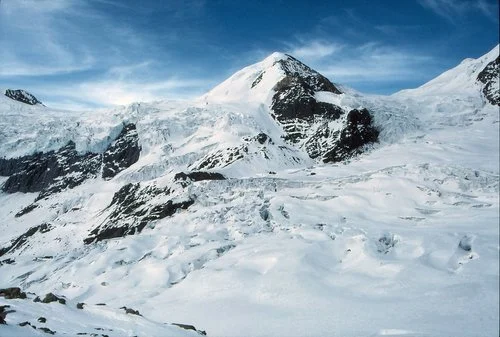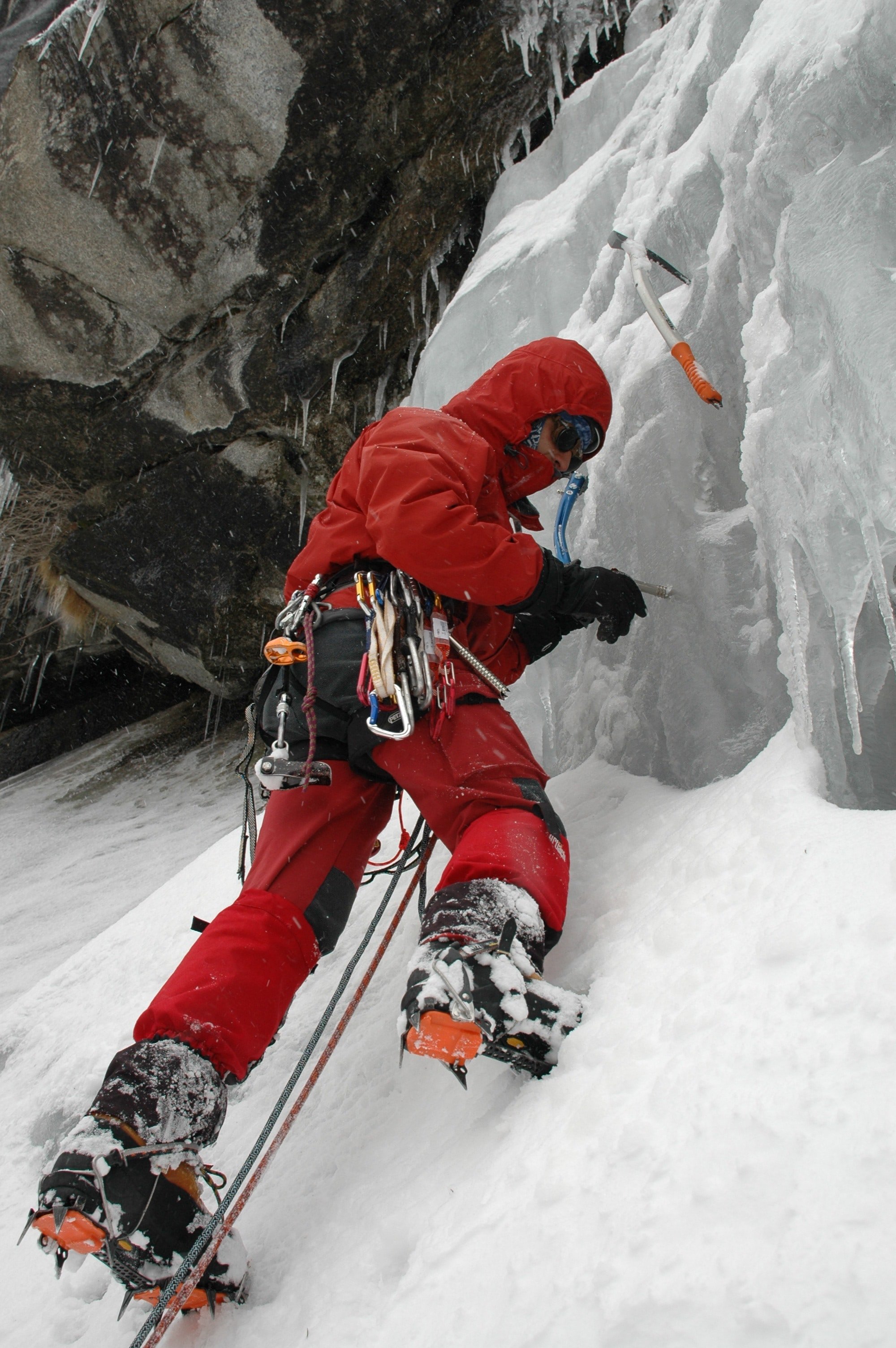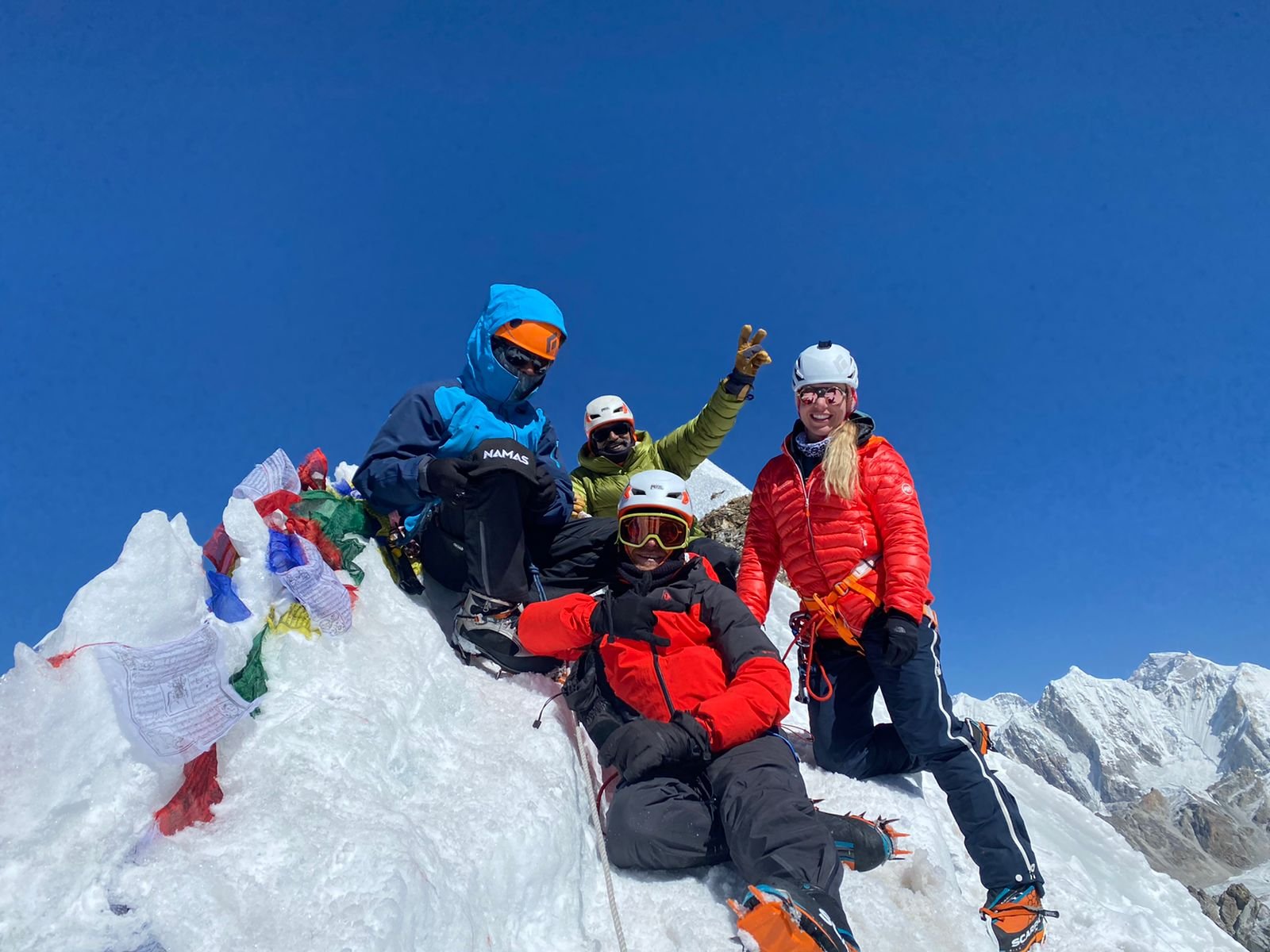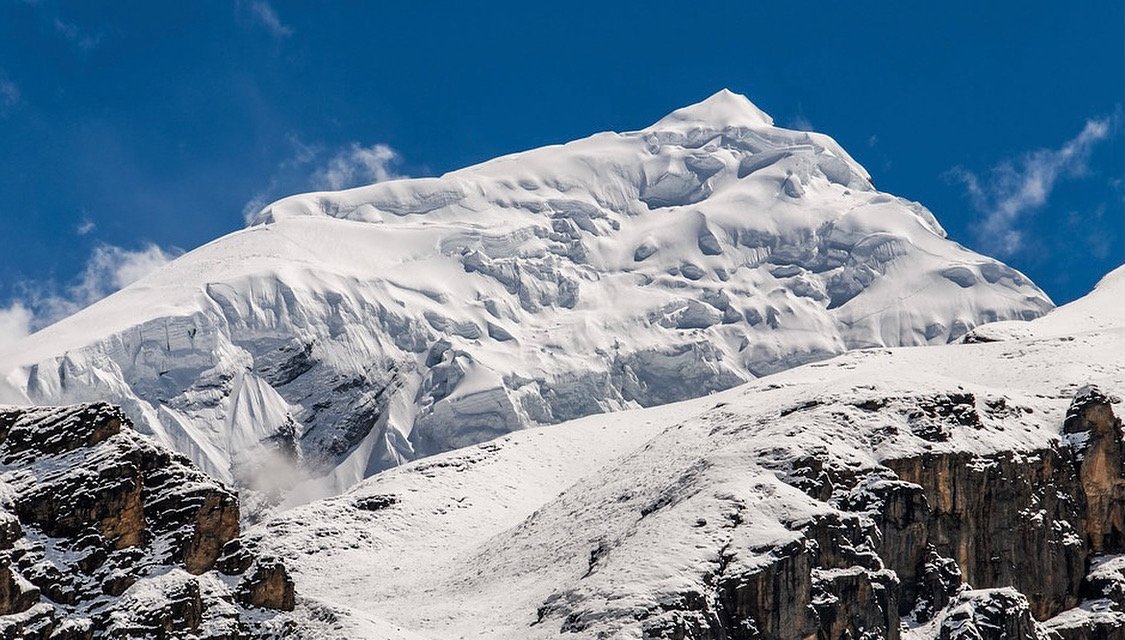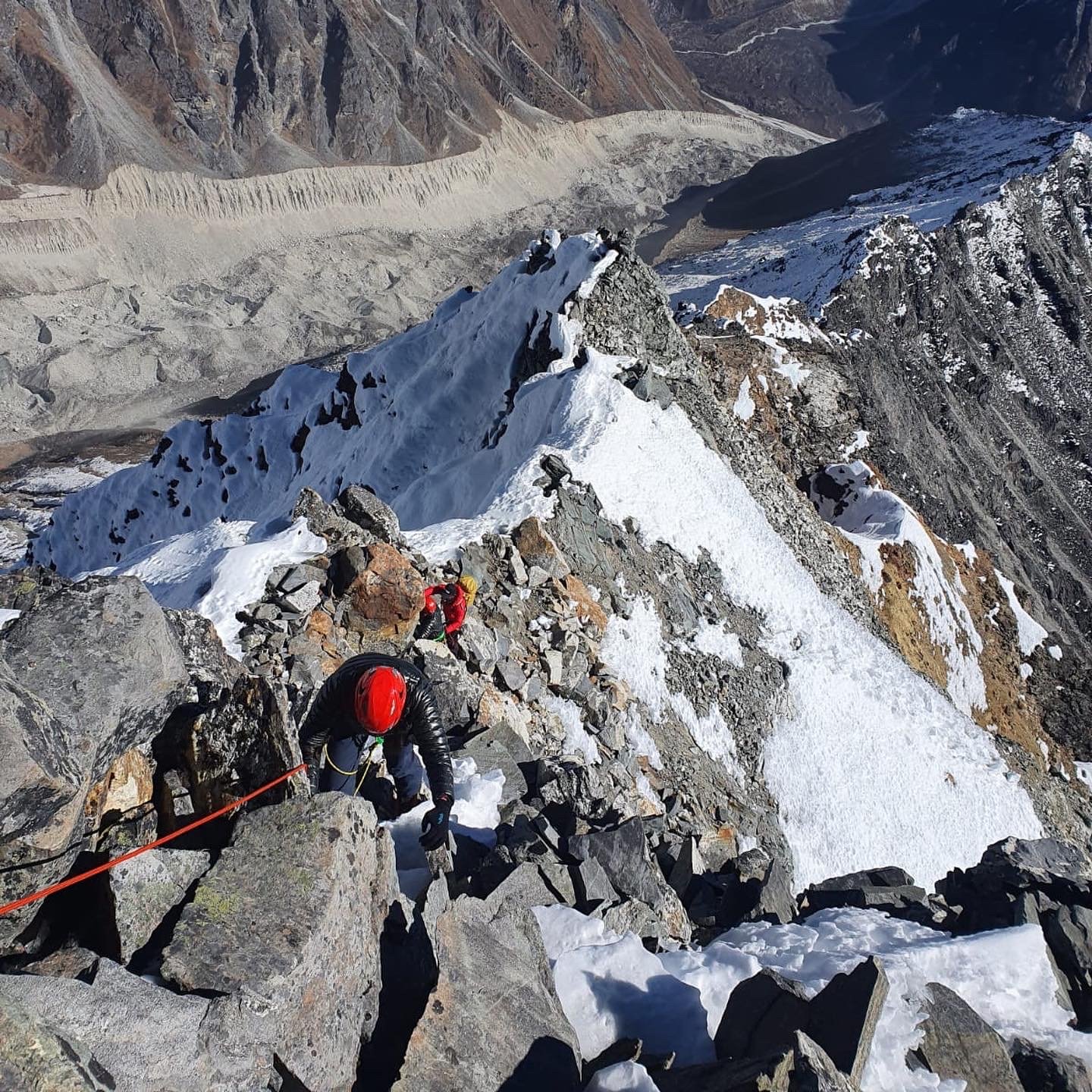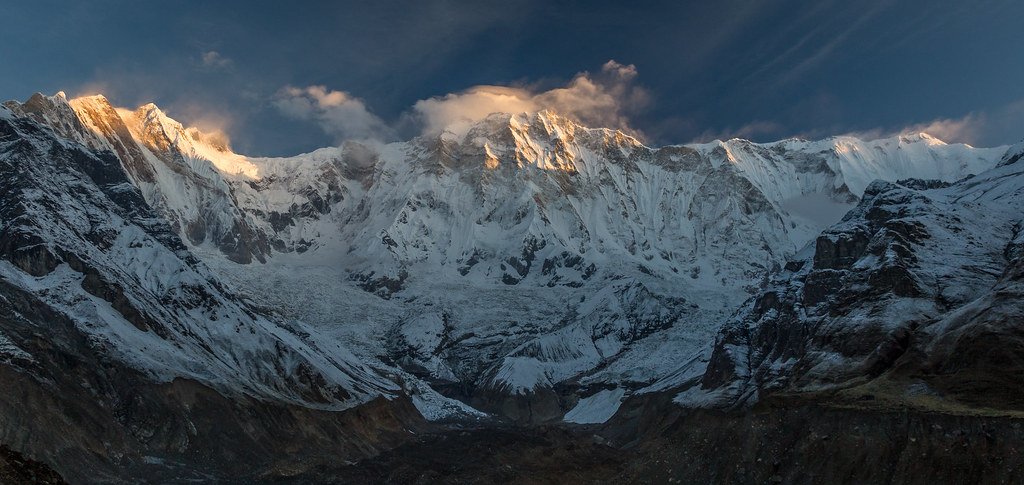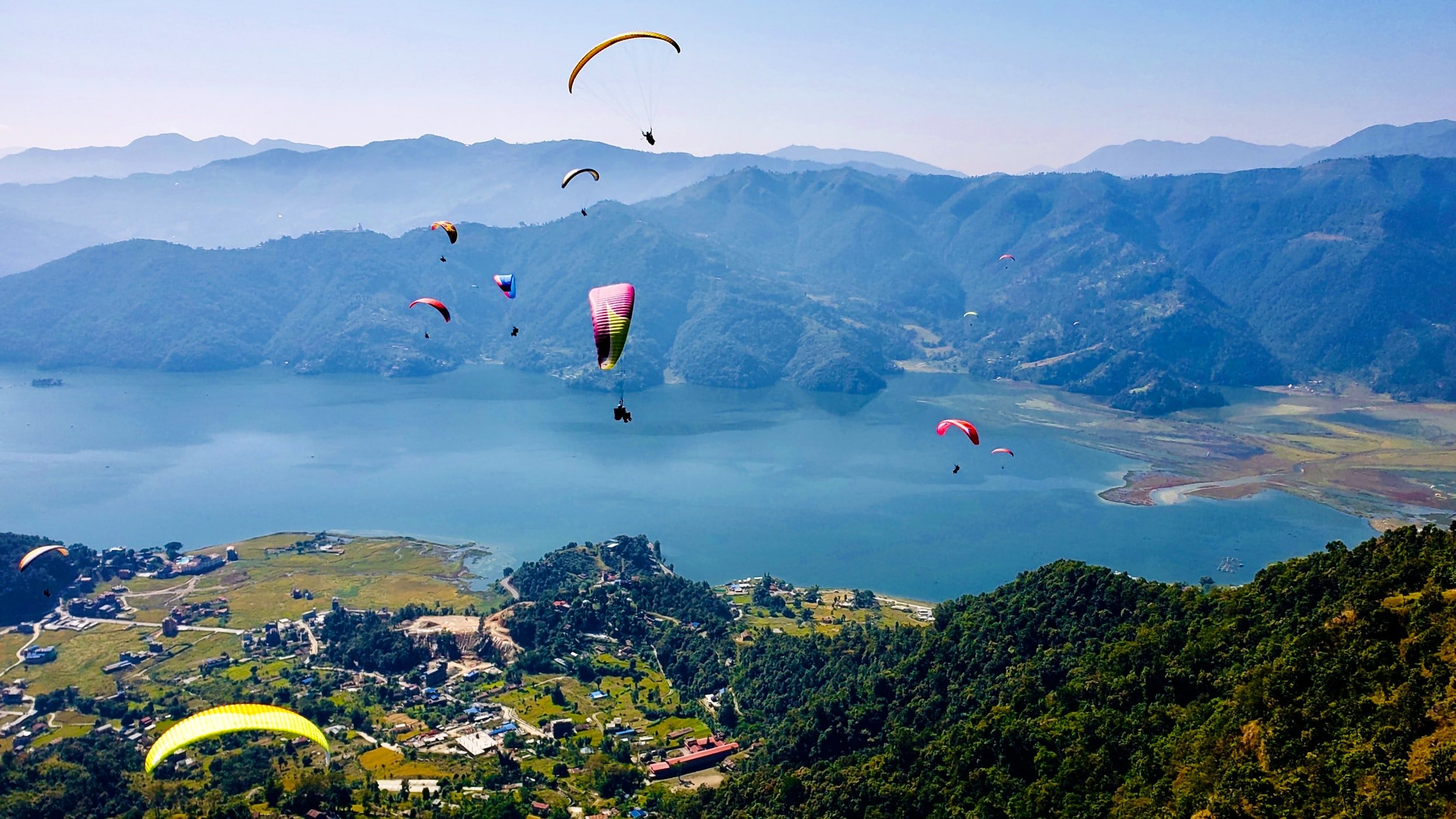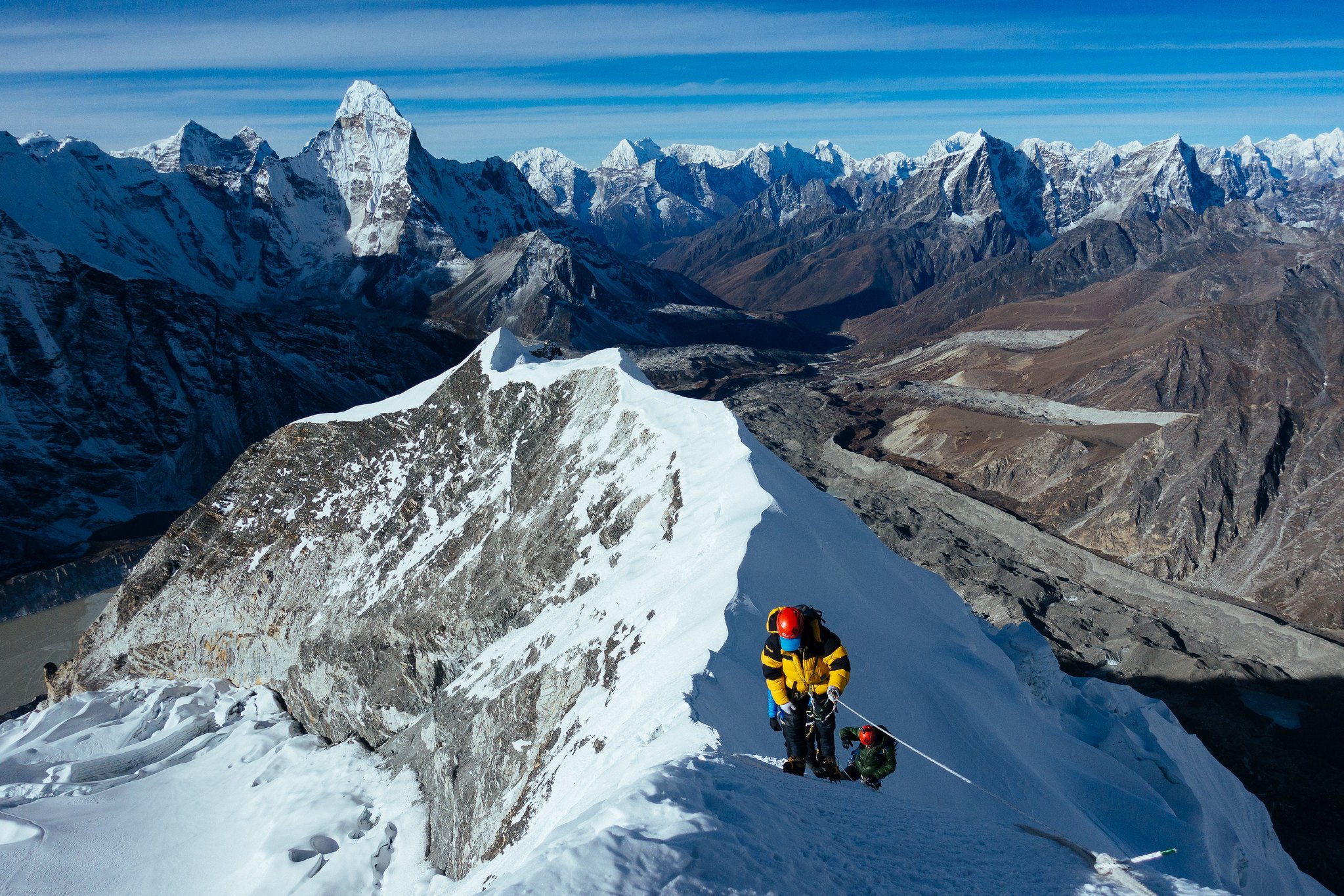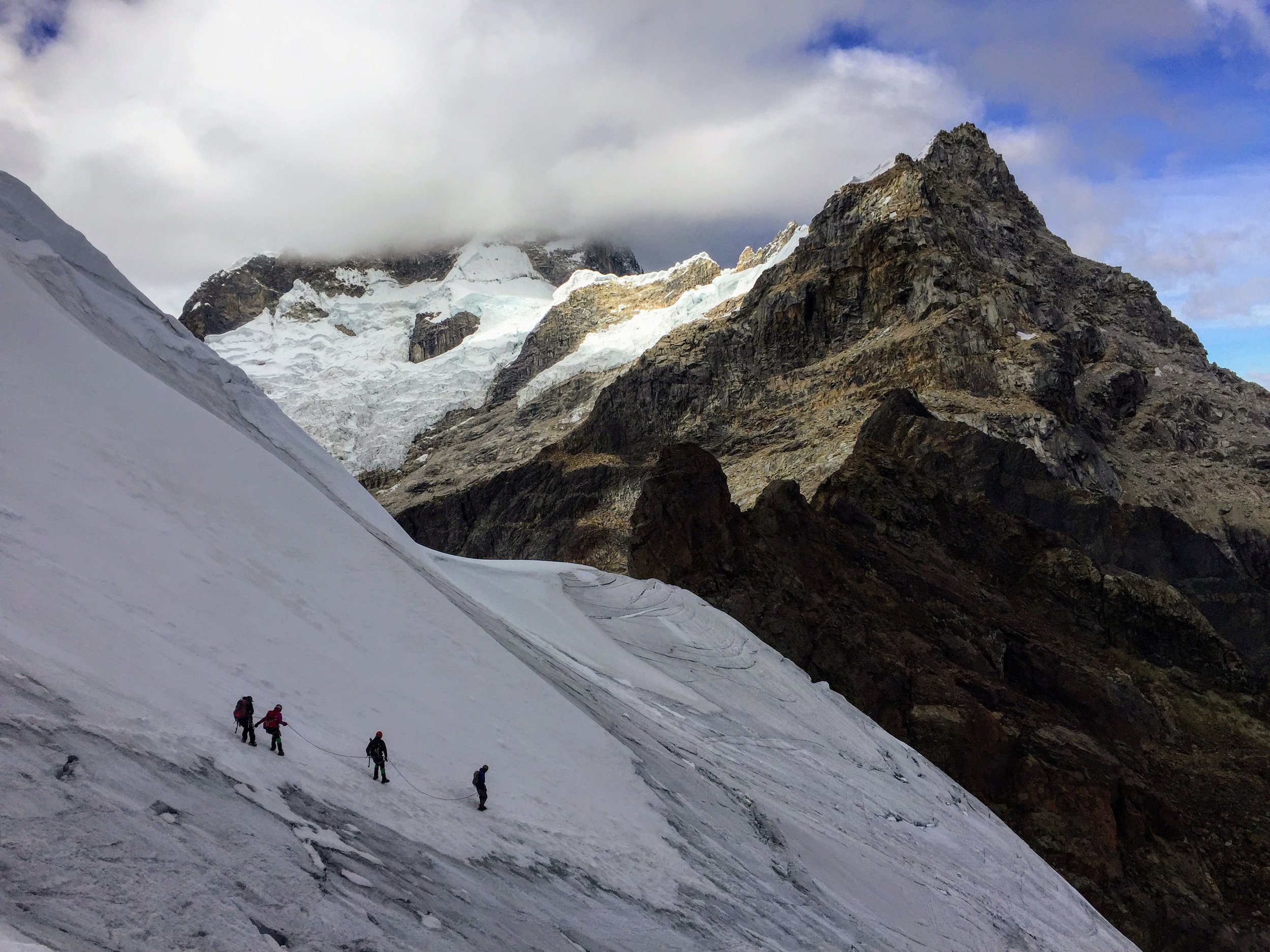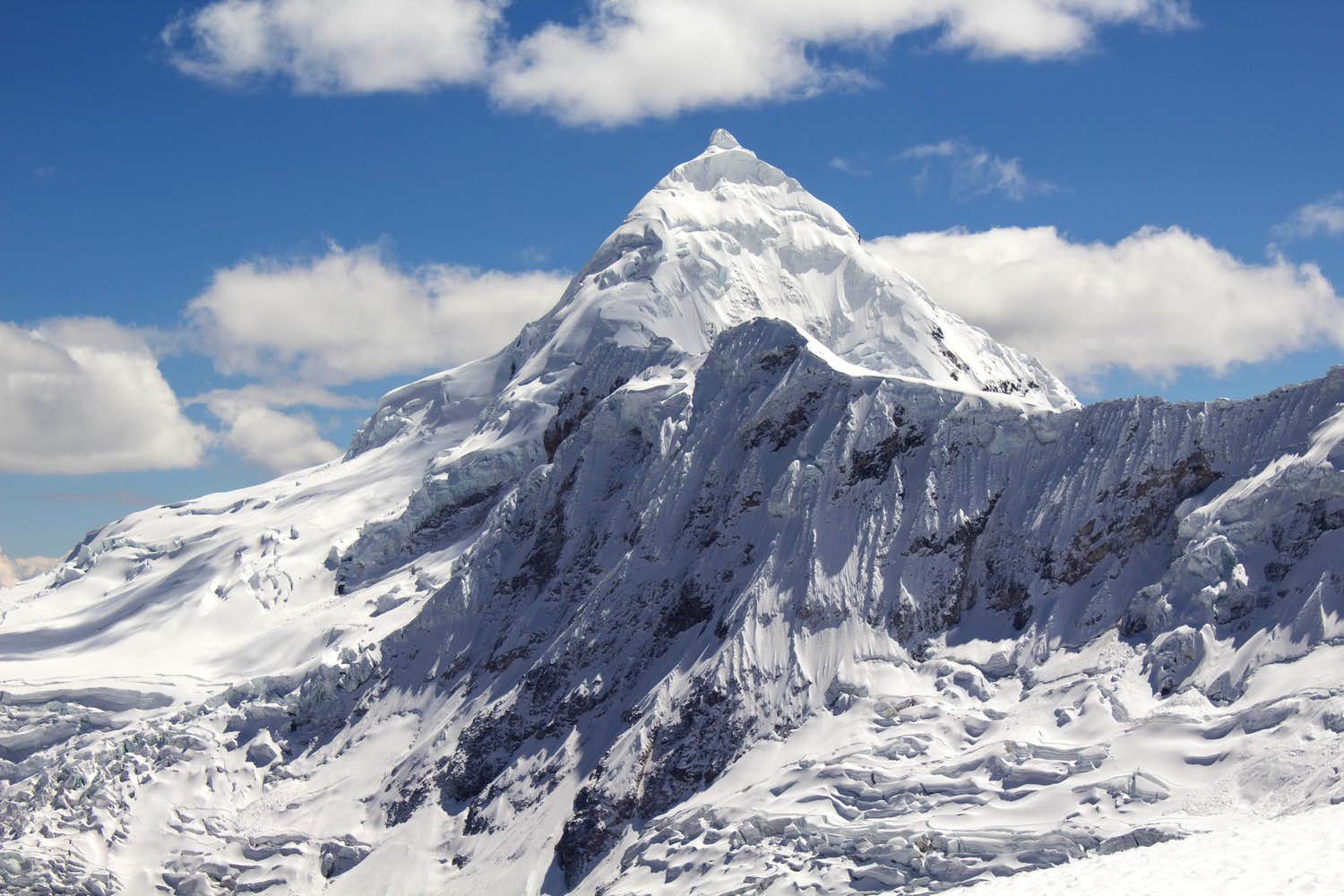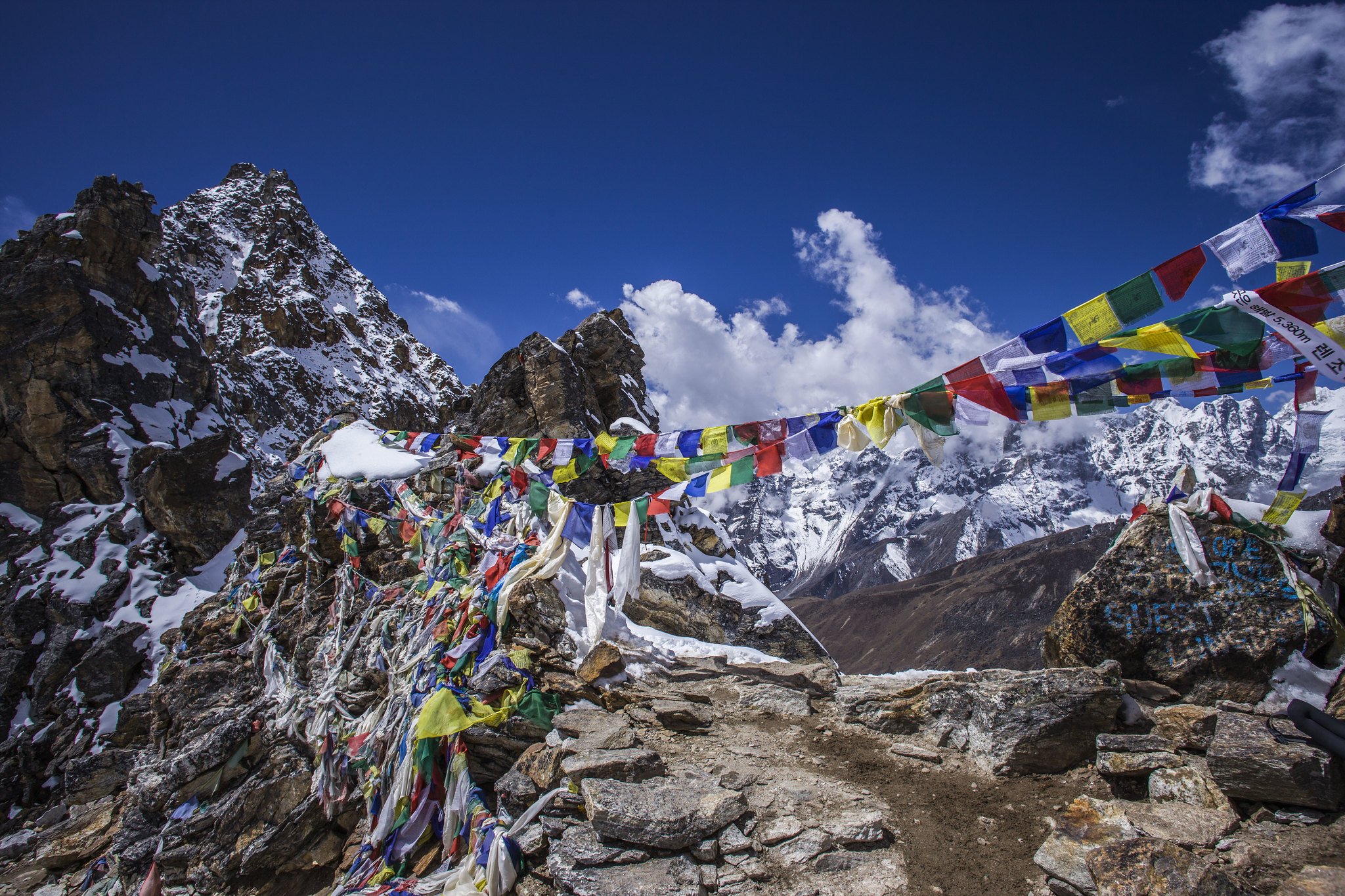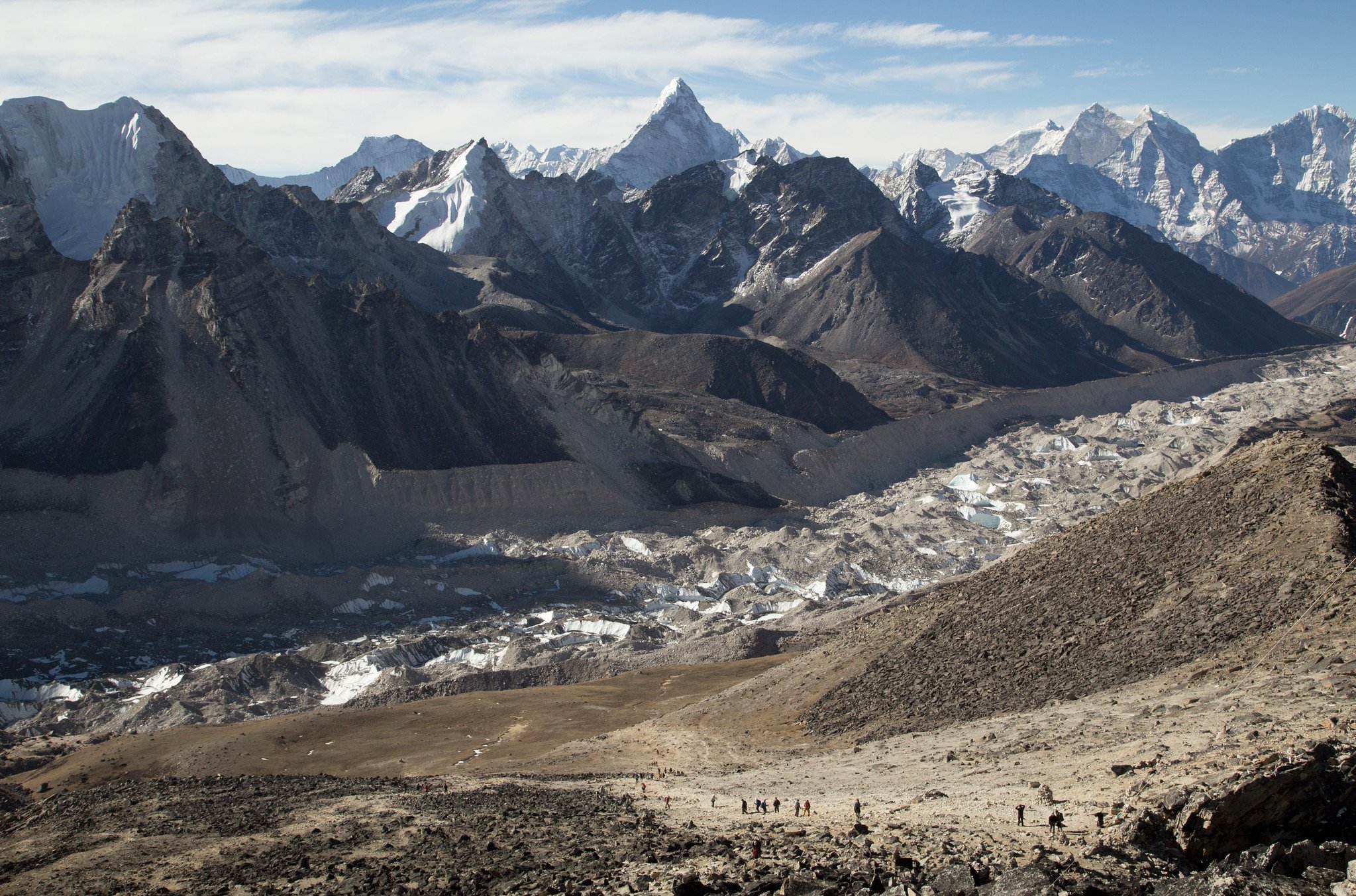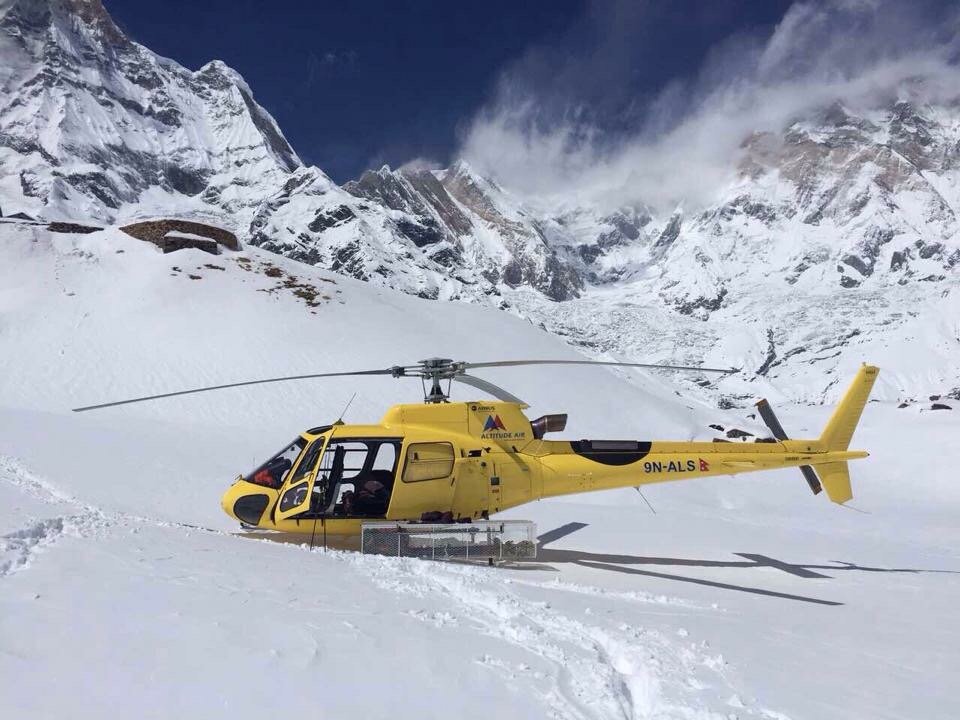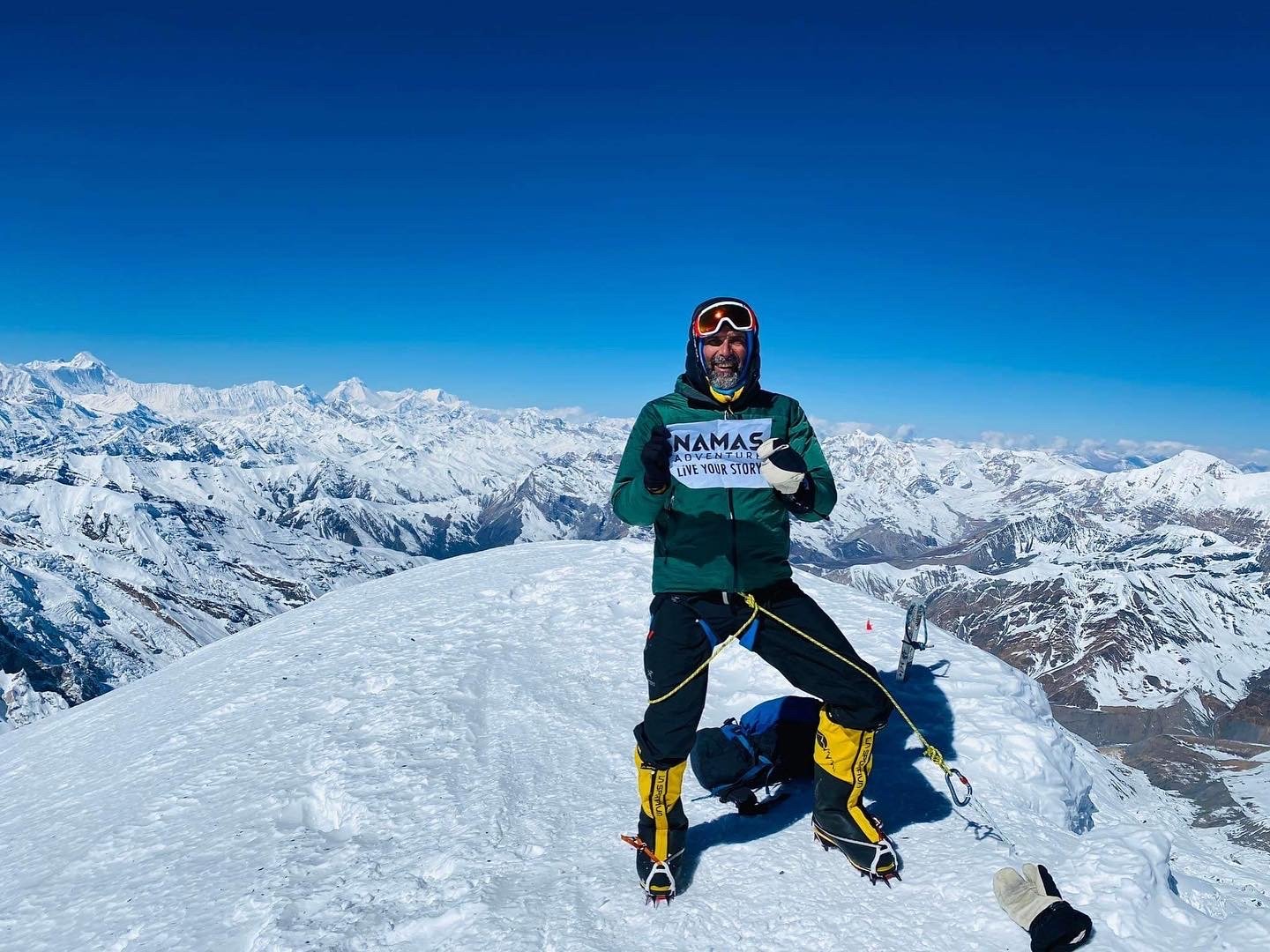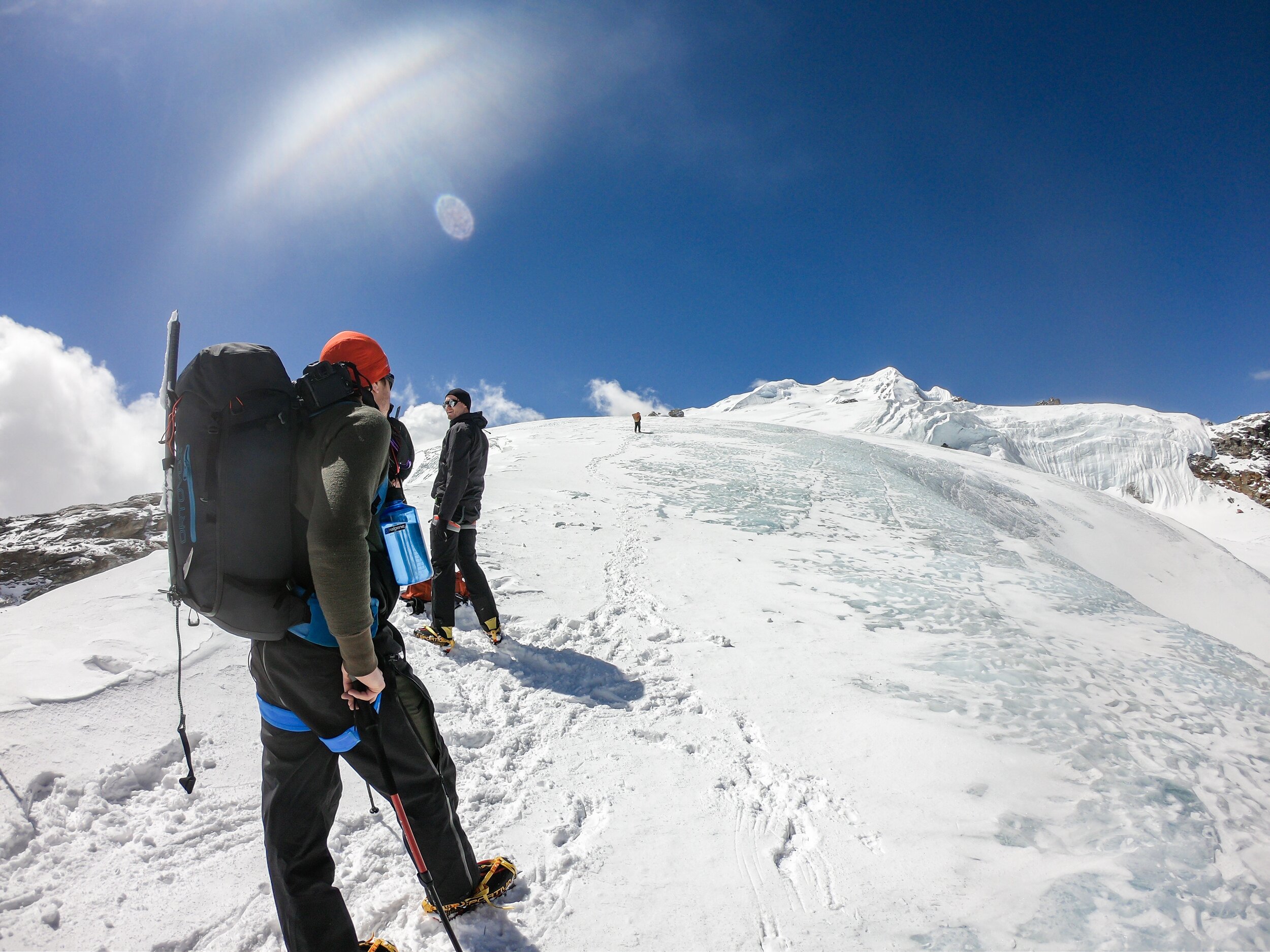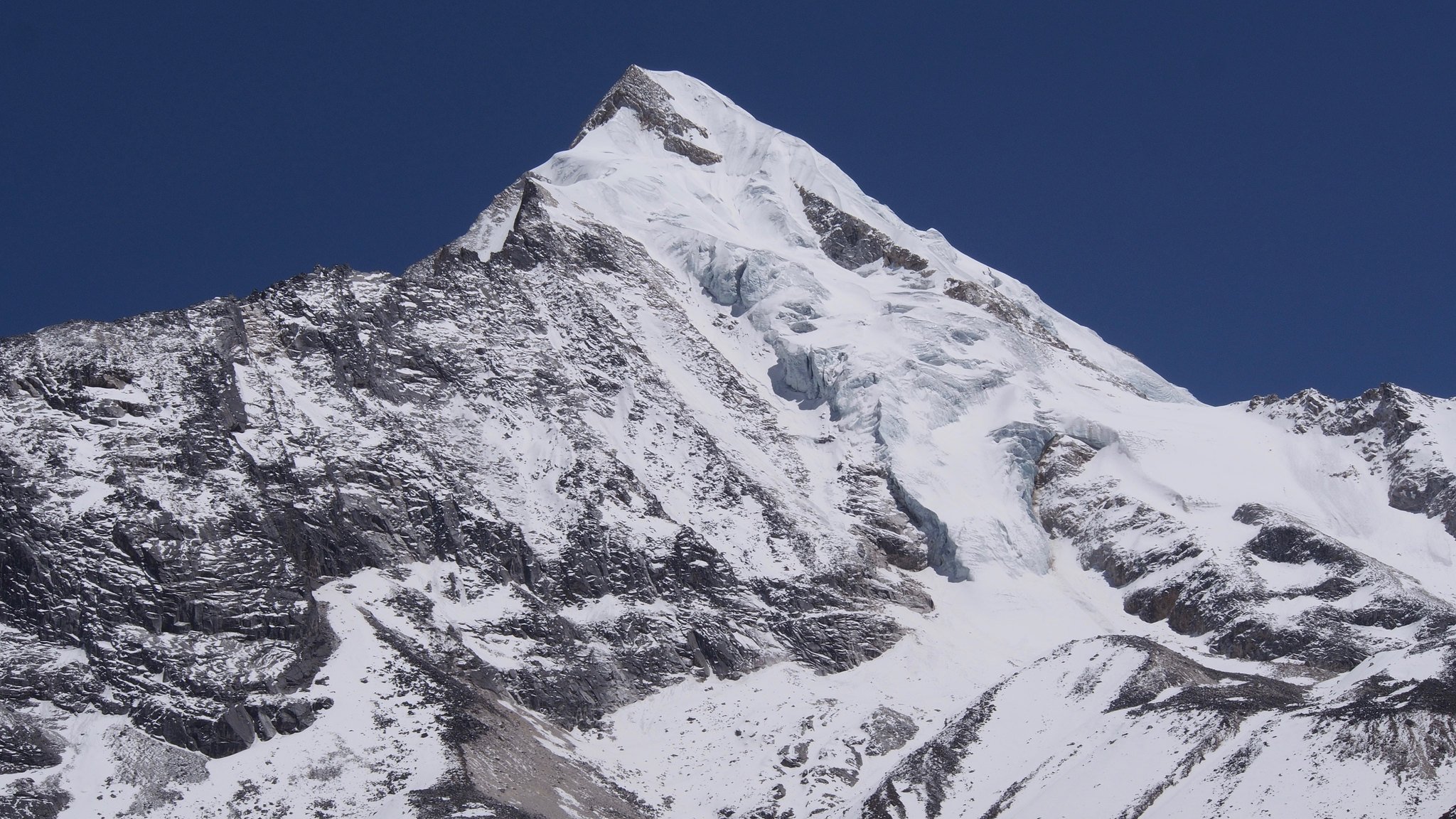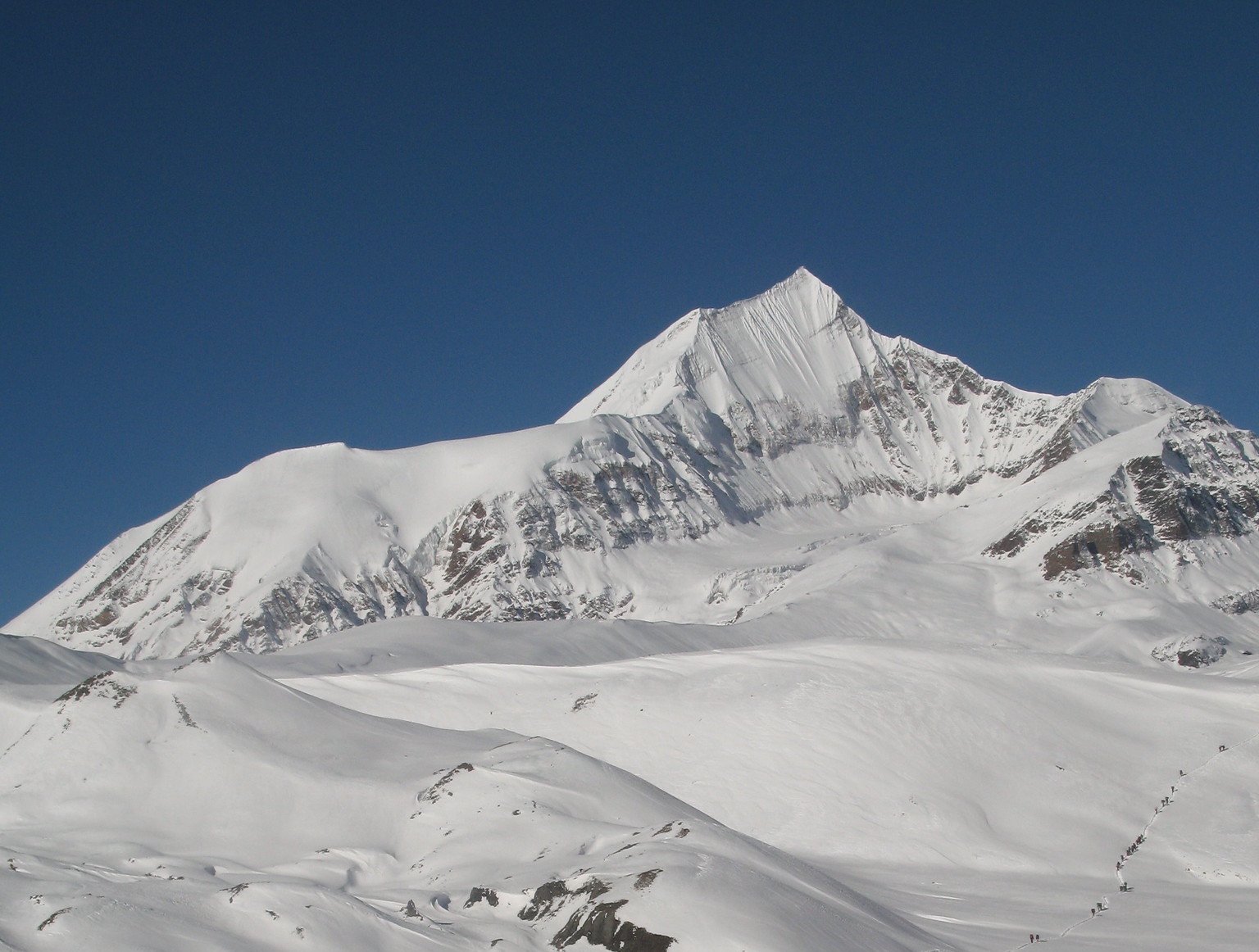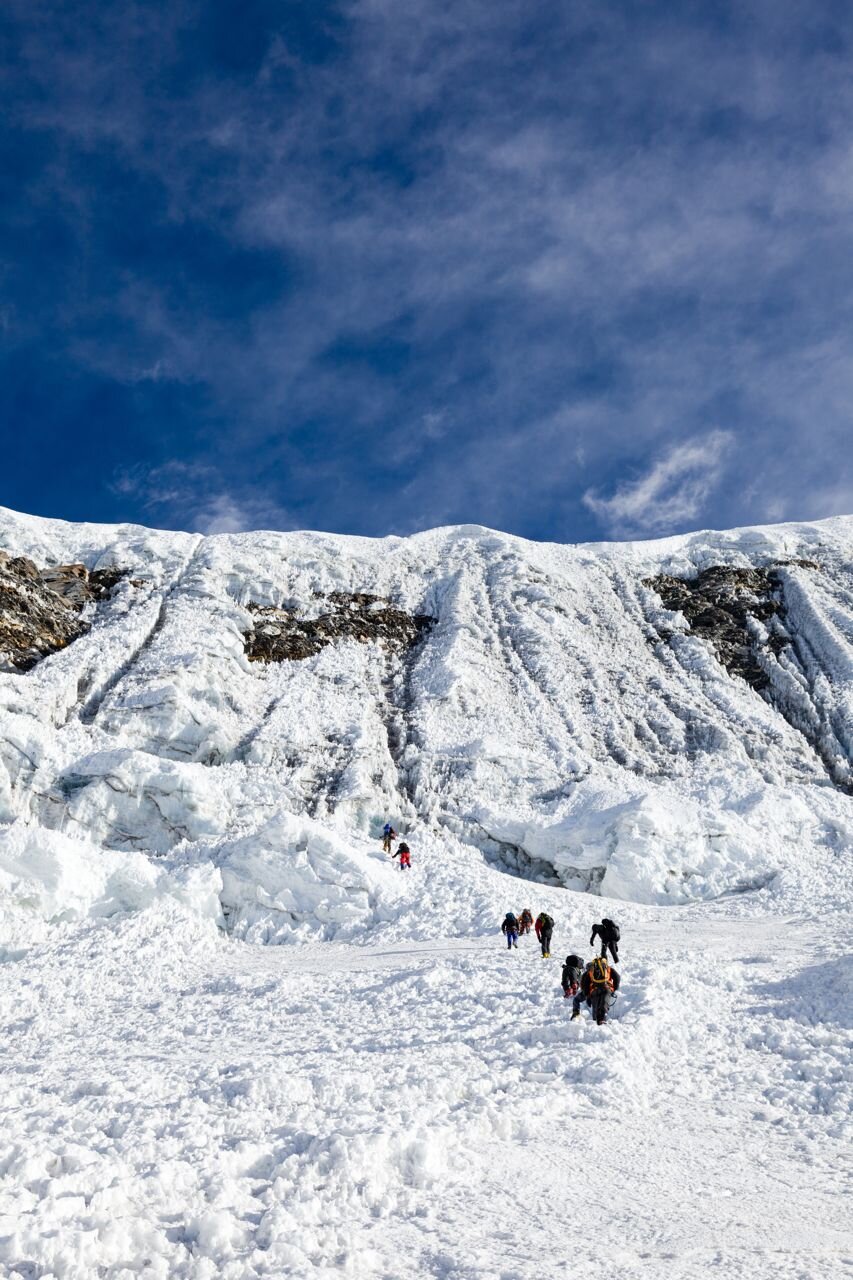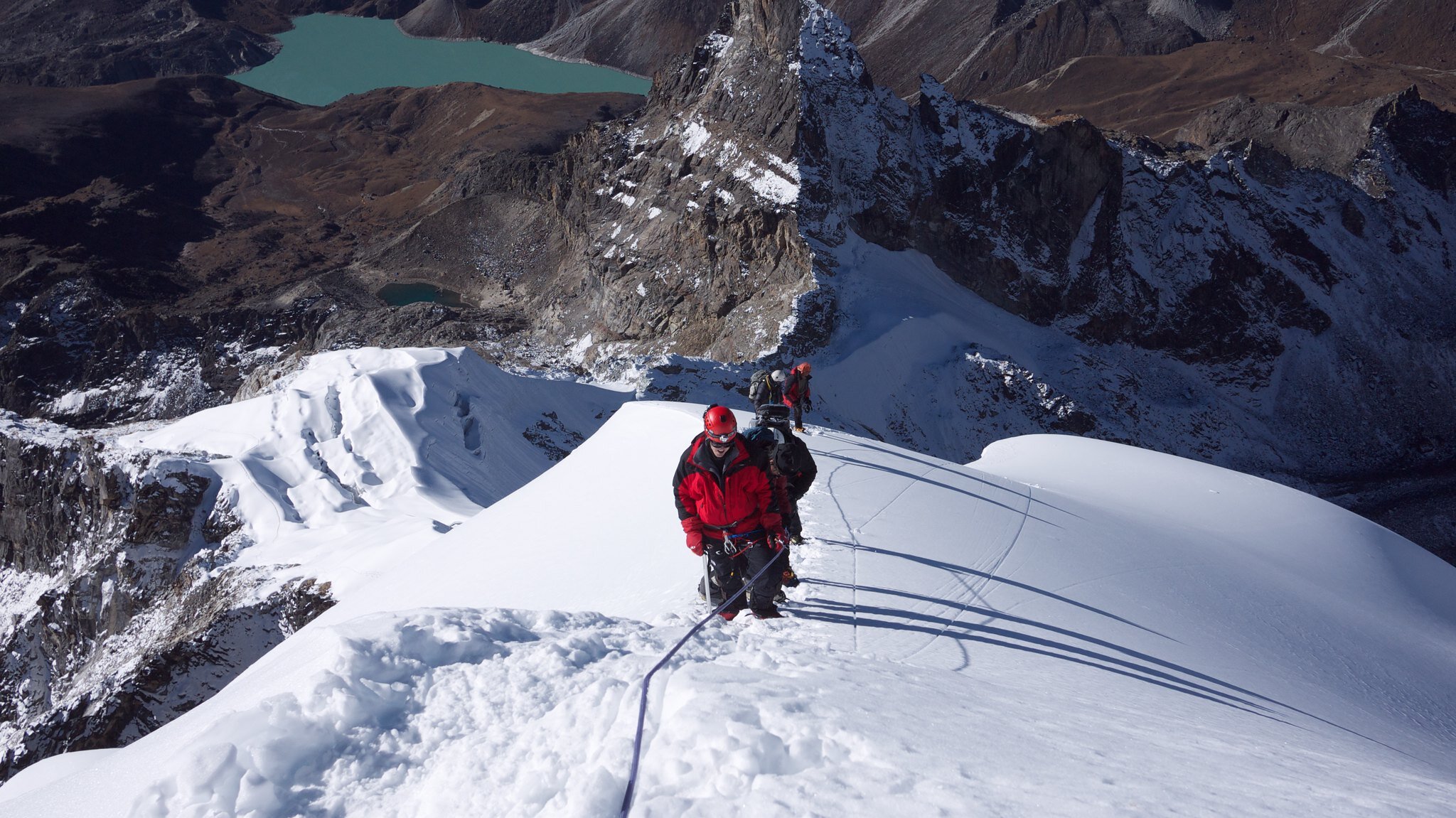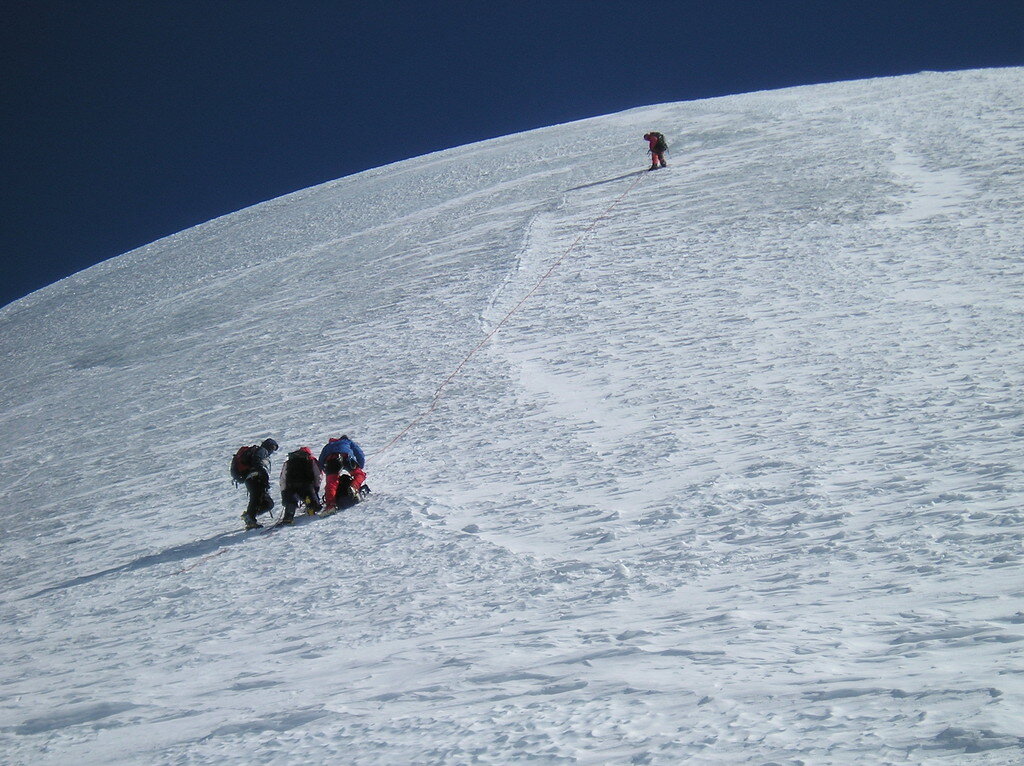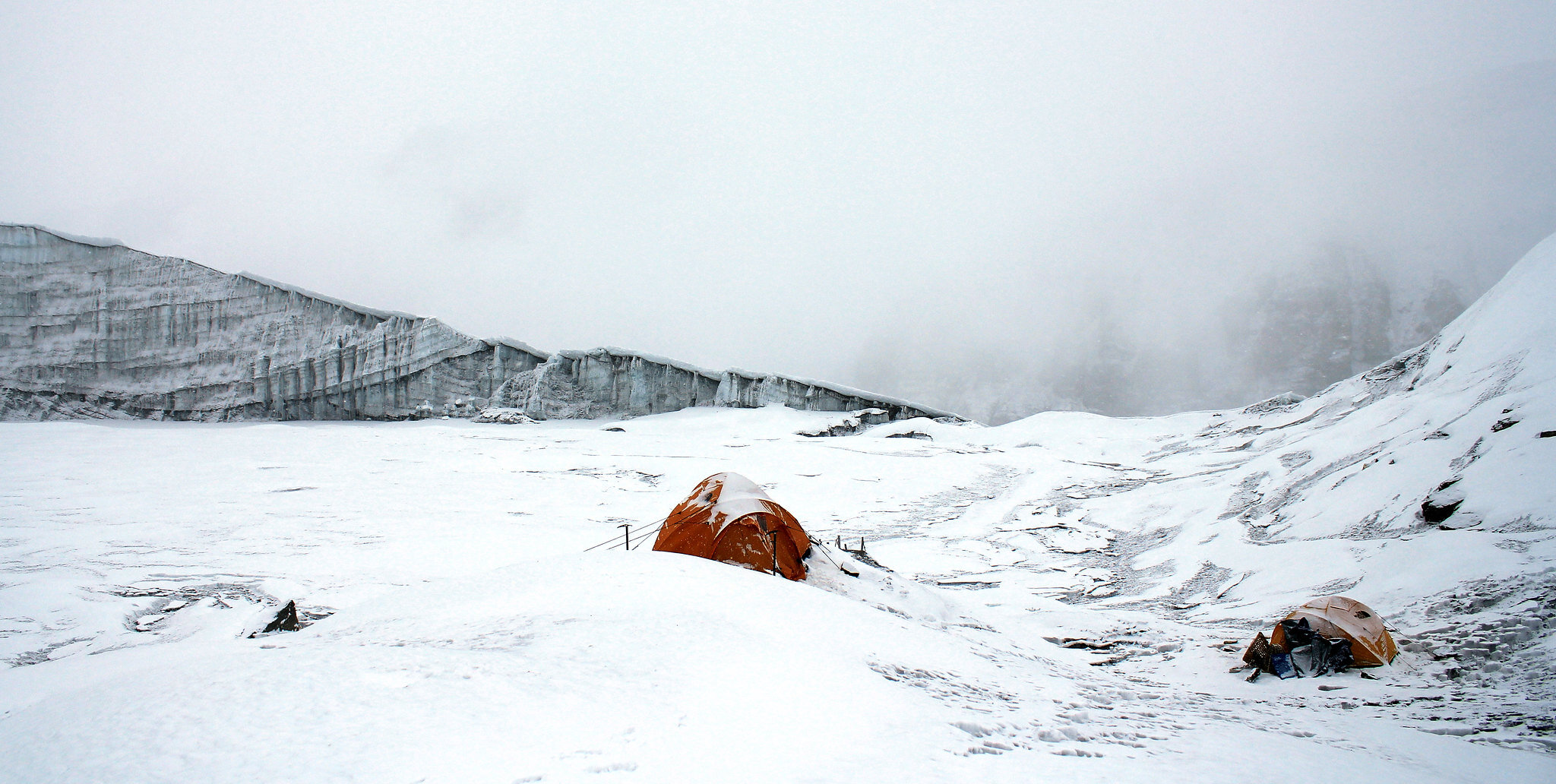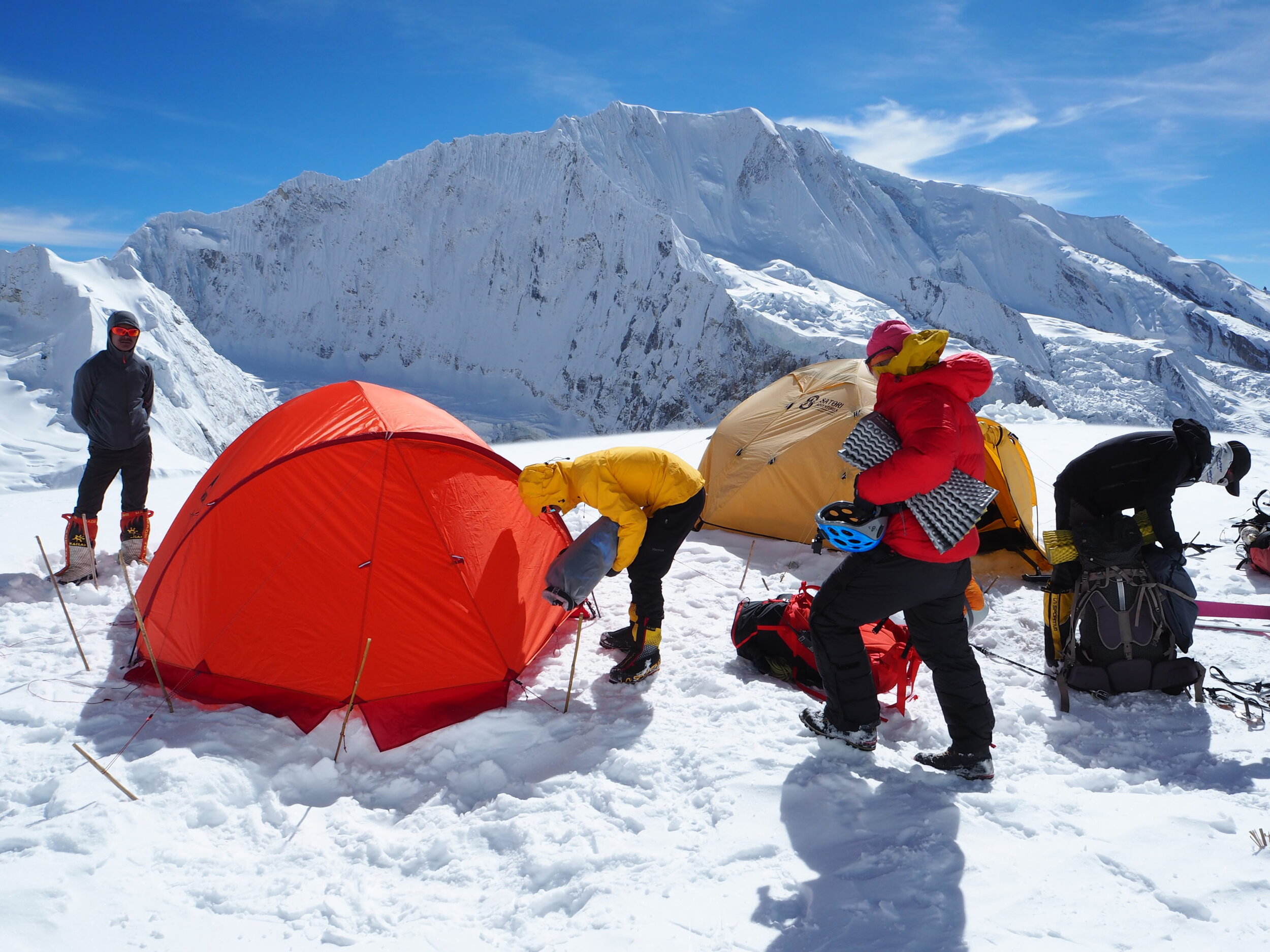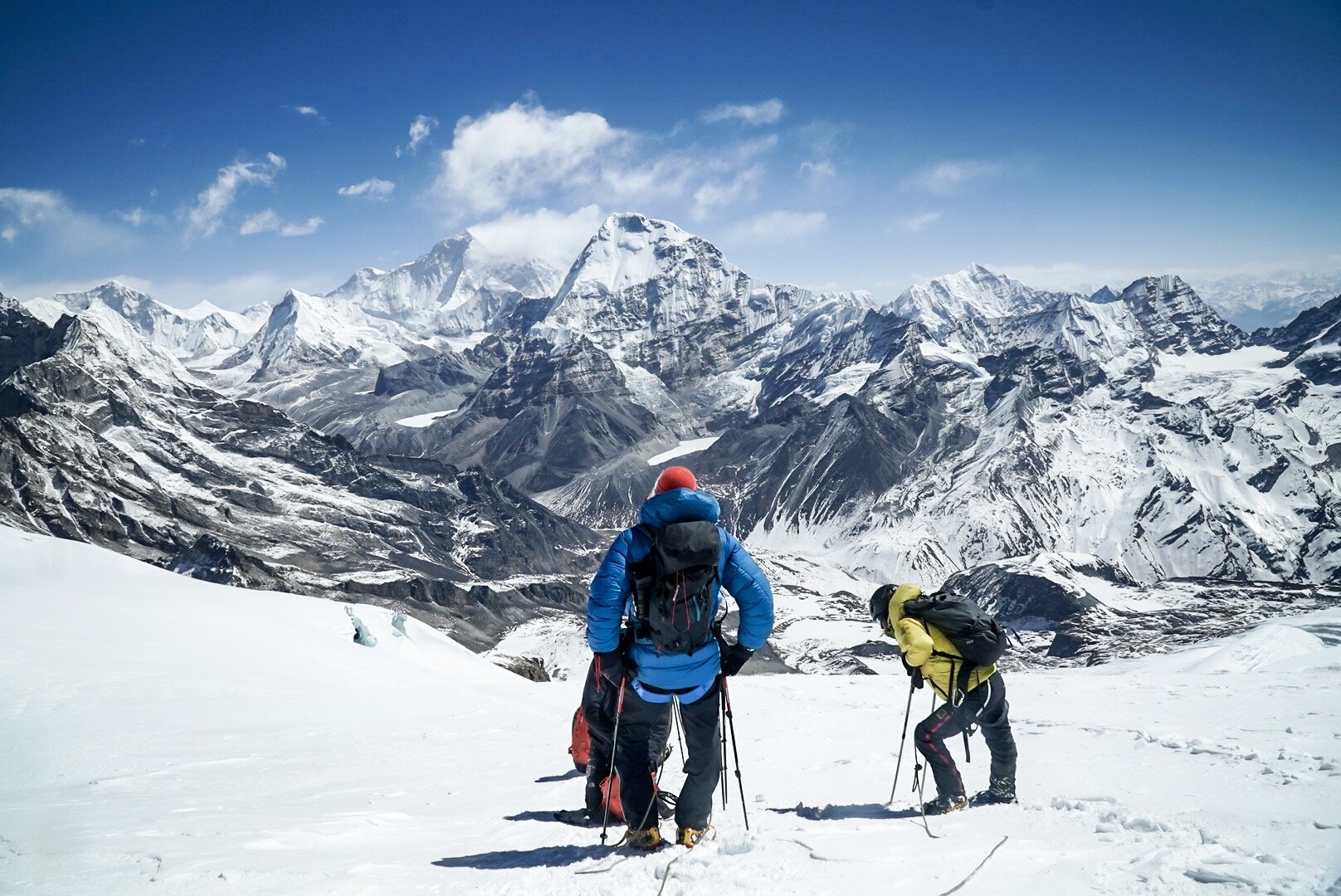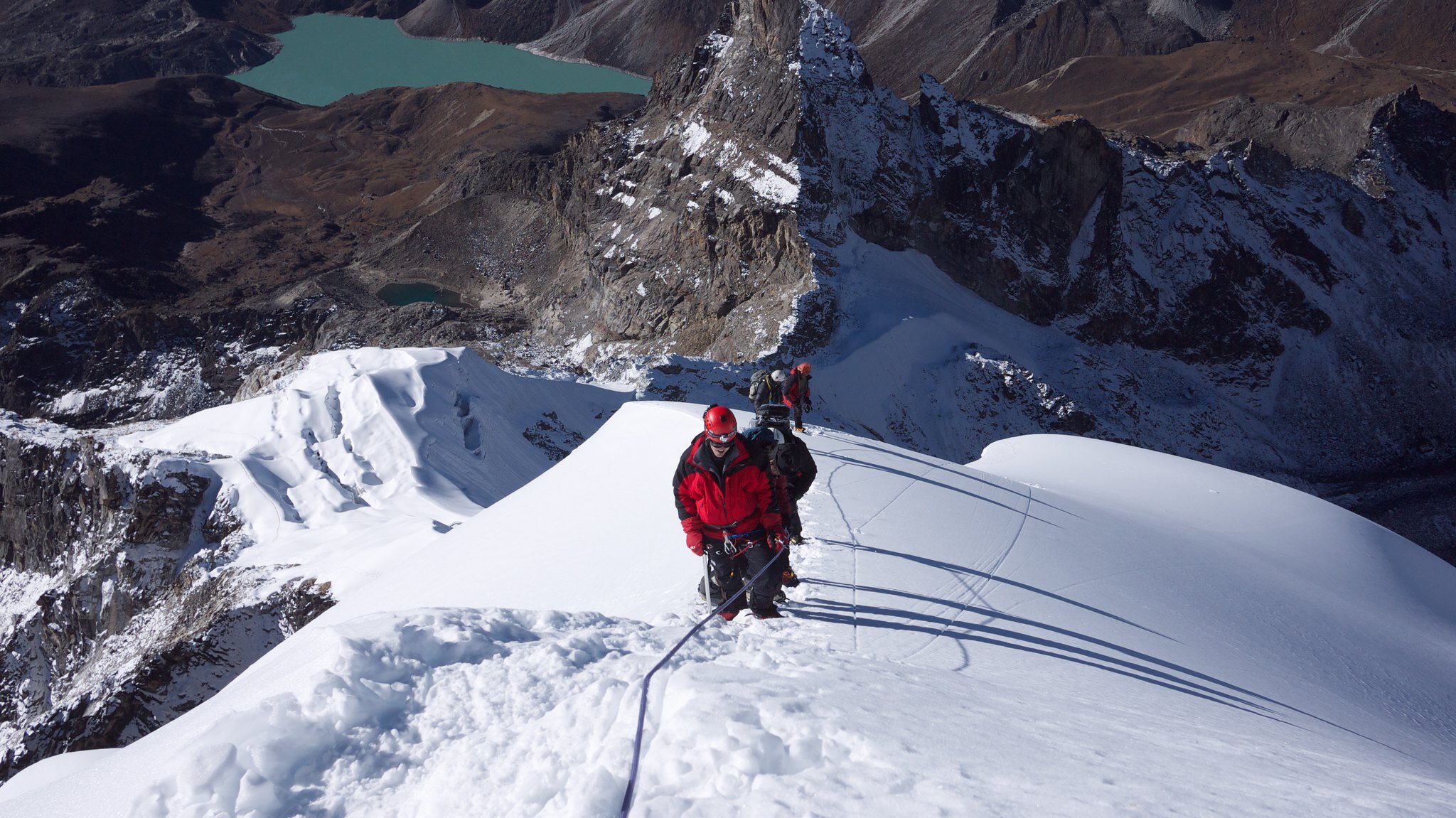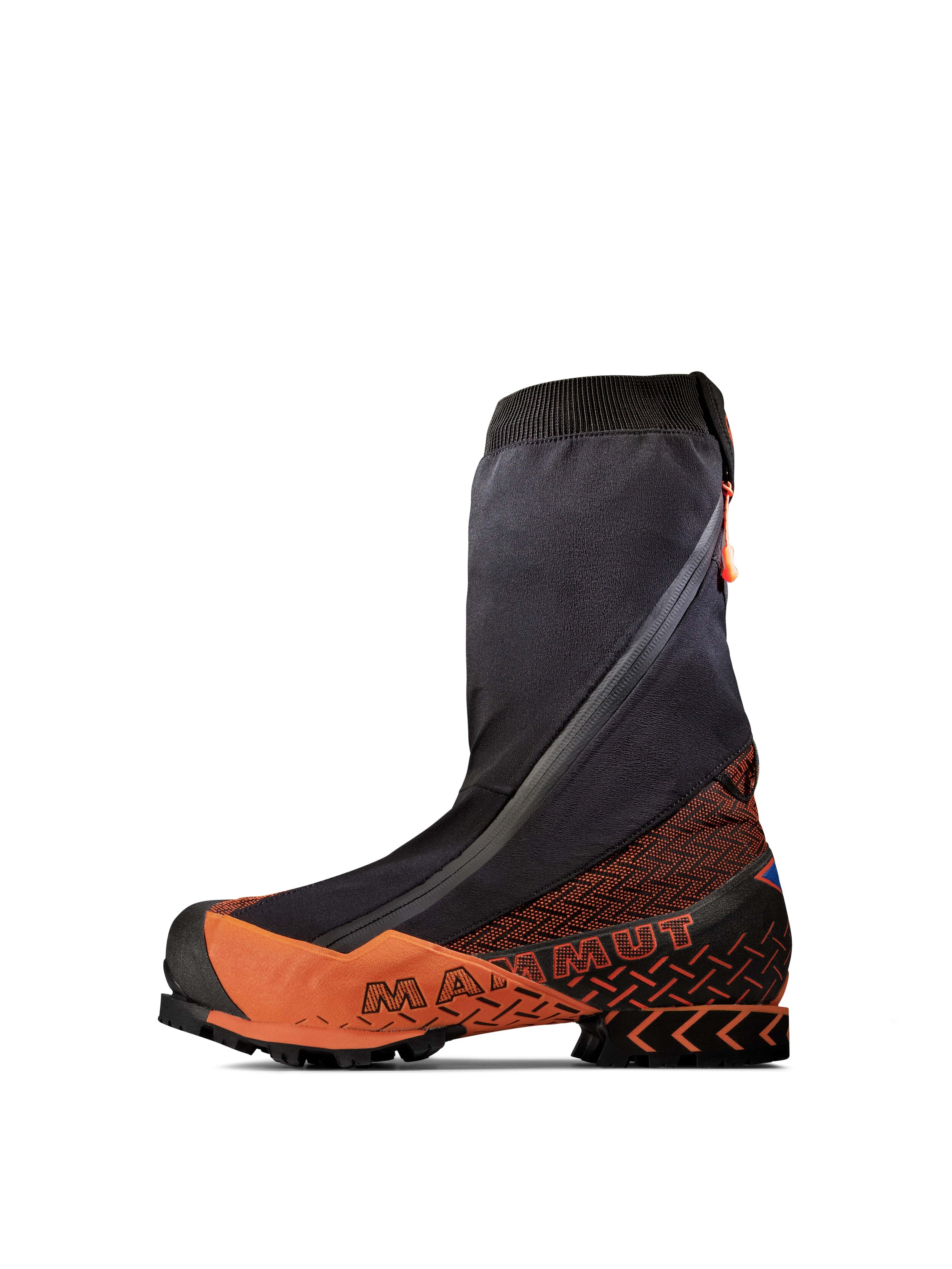Khumbu 3 Peak or Annapurna 3 Peak: Which 6000M Three Peak Challenge to Climb? – Namas Adventure

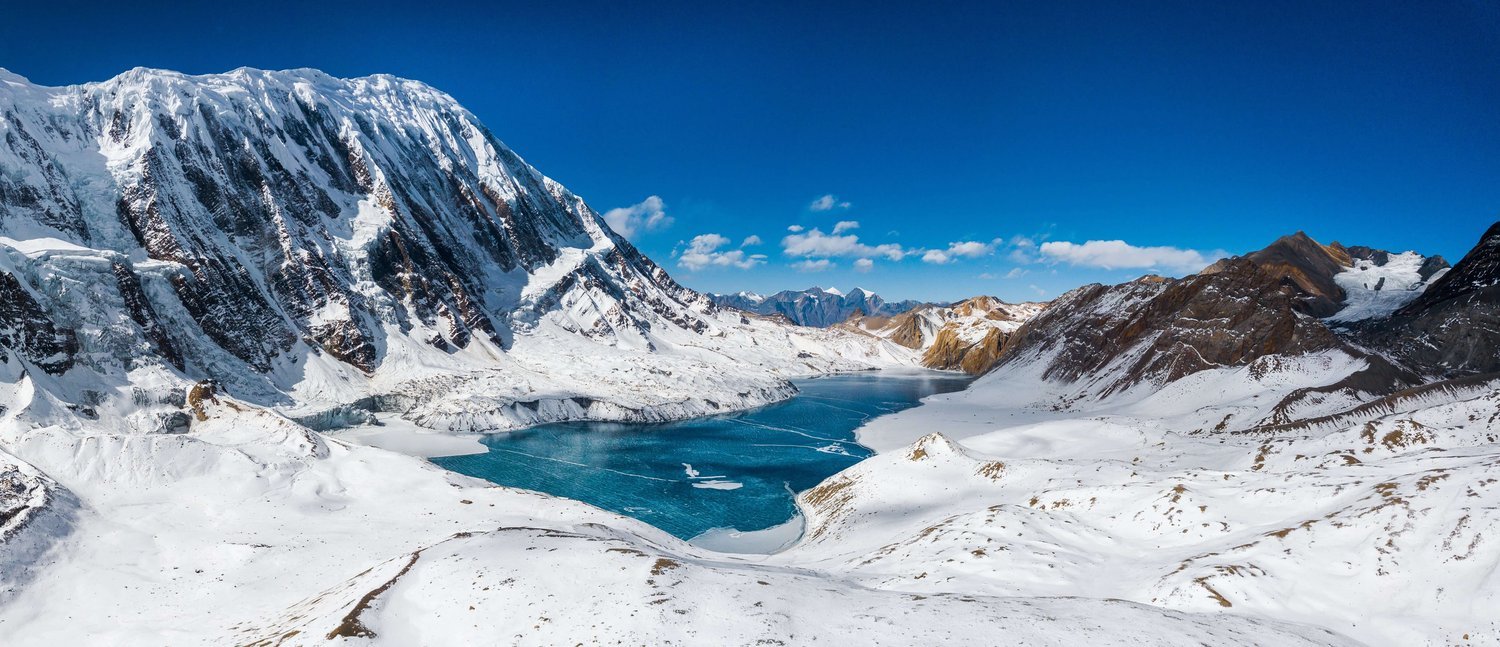
Khumbu 3 Peak vs Annapurna 3 Peak: Which One Should You Choose?
When it comes to choosing between the Khumbu 3 Peak Expedition and the Annapurna 3 Peak Expedition, it really comes down to what type of adventure you’re craving. Both expeditions offer unique experiences in Nepal’s legendary mountains, but each has its own charm. So, which one will give you the experience you’re looking for? Let’s break it down and help you figure out which one suits you best.
Khumbu 3 Peak Expedition
If you’ve ever dreamed of standing beneath the shadow of Mount Everest, the Khumbu 3 Peak Expedition might just be your dream come true. This trek will take you through the heart of the Everest region, with climbs up Mera Peak, Island Peak, and Lobuche East, offering some of the most iconic views on the planet.
Breathtaking Views of Everest: There’s something magical about looking up and seeing Everest in all its glory. On the Khumbu 3 Peak Expedition, that’s your backdrop. Along the way, you’ll pass stunning vistas of Mount Everest, Lhotse, Makalu, and several other towering peaks. The scenery here is second to none.
Climbing Variety: The climbs themselves will challenge you in different ways. Mera Peak is more straightforward, but Island Peak and Lobuche East will push your skills. Island Peak is particularly technical, with a steel ladder over crevasses and a steep ascent to the summit. It's an exhilarating climb, one that makes you feel like you're truly on an adventure.
Immersive Sherpa Culture: The Khumbu region is rich in Sherpa culture, and throughout your journey, you’ll have the opportunity to learn about the people who call this rugged terrain home. The culture here is as awe-inspiring as the mountains themselves, and this expedition gives you a chance to connect with it on a personal level.
The Khumbu 3 Peak Expedition is perfect for anyone who dreams of Everest and is looking to challenge themselves both physically and mentally, while experiencing the deep-rooted Sherpa culture.
Annapurna 3 Peak Expedition:
If you’re drawn to quieter trails, breathtaking mountain scenery, and a bit less foot traffic, the Annapurna 3 Peak Expedition might be more your style. Set in the stunning Annapurna region, this trek takes you through serene villages and alpine landscapes as you climb Chulu West, Chulu Far East, and Pisang Peak.
Less Crowded, Just as Beautiful: The Annapurna region is just as stunning as the Everest region, but without the same level of traffic. If you’re looking for a more peaceful, less commercialized trekking experience, the Annapurna 3 Peak Expedition offers that. You’ll have more space to breathe and a chance to enjoy the beauty of the Himalayas without the crowds.
Cultural Immersion: As you trek through villages like Manang and explore the Annapurna massif, you’ll get a much deeper sense of local life. The Annapurna region is home to rich traditions, and this trek offers you a chance to connect with the communities in a more relaxed setting.
Challenging, but Rewarding Climbs: The climbs here are a perfect mix of technical and moderate. Chulu West is the most technical of the three, with some tricky climbing near the summit, while Pisang Peak is more moderate but still a solid challenge. The Annapurna peaks offer a different kind of challenge, one that combines a sense of adventure with a touch of serenity.
If you're someone who prefers a more peaceful, cultural experience while still facing a great physical and mental challenge, the Annapurna 3 Peak Expedition will feel like home.
So, Which One Should You Choose?
Ultimately, the decision between the Khumbu 3 Peak Expedition and the Annapurna 3 Peak Expedition depends on what kind of experience you're hoping to get out of it.
Choose the Khumbu 3 Peak Expedition if you want the full Everest experience — think iconic views, a variety of climbing challenges, and the chance to immerse yourself in the unique Sherpa culture. If you’ve always dreamed of seeing Everest up close and want to push yourself with some technical climbs, this is the expedition for you.
Choose the Annapurna 3 Peak Expedition if you want a quieter, more peaceful trek in a beautiful, less-crowded region. The Annapurna massif is every bit as stunning as Everest, and with its beautiful villages and serene landscapes, you’ll experience the Himalayas in a more intimate setting. Plus, the climbing is no less challenging — you’ll still be tested, but with a slightly different vibe.
Both expeditions are designed for climbers who are physically prepared and ready to take on 6000-meter peaks, and both will challenge you in different ways. Both are full of rewards — stunning landscapes, unforgettable summits, and the sheer joy of being in the heart of the Himalayas.
The Bottom Line: Both Are Life-Changing Experiences
Whichever you choose, both the Khumbu 3 Peak Expedition and the Annapurna 3 Peak Expedition will offer you the chance to test your limits, experience some of the most incredible landscapes on Earth, and leave you with memories that last a lifetime. They’re both excellent introductions to Himalayan climbing and will help you develop skills and confidence for bigger climbs in the future. At the end of the day, it’s all about what kind of experience you’re looking for. Whether it’s the towering peaks and cultural richness of Khumbu or the quieter, intimate beauty of Annapurna, you’ll find adventure, challenge, and inspiration in either one.
If you’re ready for the challenge, we would love to have you join us on this unforgettable adventure. For more information, feel free to contact us at bookings@namasadventure.com.
Climb higher. Embrace the challenge. And become the adventurer you were always meant to be.
Live Your Story!
Annapurna Three Peak Expedition: Building Blocks for Greater Adventures
There’s something magical about the mountains — the vastness, the challenge, and the quiet beauty that stretches beyond the horizon. It’s the kind of place that calls you to test your limits, to push beyond what you think is possible. And if you’re like many mountaineers, that call is hard to ignore.
For those ready to take that leap, the Annapurna Three Peak Expedition, which includes Chulu West, Chulu Far East, and Pisang Peak, offers an incredible opportunity. These climbs are not just about reaching the summit — they’re about building the foundation for bigger adventures. They’re the first step in a journey that could eventually take you to the highest peaks in the Himalayas.
What You’ll Experience on the Way
Climbing these peaks isn’t just about reaching the summit — it’s about everything that happens on the way up. You’ll experience challenges that test your body and mind. There will be moments of doubt, but also moments of pure joy as you overcome those challenges. You’ll face the weather, deal with tiredness, and learn how to keep your focus when everything seems to be working against you.
And when you do finally stand on the summit — whether it’s Chulu West, Chulu Far East, or Pisang Peak — you’ll experience that indescribable feeling of accomplishment. The view from the top is surreal, a reminder of how far you’ve come, and a glimpse of how much more there is to see.
Preparing for Bigger Adventures
Once you’ve completed the Annapurna Three Peak Expedition, you’ll be better prepared for the bigger, more challenging climbs. You’ll have the mental strength, technical skills, and high-altitude experience needed to take on climbs like Baruntse, Himlung, or even the mighty Manaslu. These peaks give you the chance to understand what it’s like to be in the mountains for longer periods, where the challenges are tougher and the stakes are higher.
But that’s the beauty of climbing — it’s not just about the destination, it’s about the journey. Each climb, no matter the size, teaches you something new and pushes you to grow. The Annapurna Three Peak Expedition is one of the most rewarding ways to get started on that journey, setting you up for success on the next, bigger challenge.
Ready to Take on the Annapurna Three Peaks?
If you’re thinking about joining the Annapurna Three Peak Expedition, or you’re interested in 6,000m+ peaks, we’re here to guide you. Our experienced guides, who are IFMGA and NMA-certified, will provide the support, knowledge, and encouragement you need to reach the top.
We understand that every climb is a personal journey, and we’re committed to making sure you feel safe, supported, and empowered throughout your expedition. From the technical aspects to the emotional highs and lows, we’re with you every step of the way.
If you’re ready for the challenge, we would love to have you join us on this unforgettable adventure. For more information, feel free to contact us at bookings@namasadventure.com.
Climb higher. Embrace the challenge. And become the adventurer you were always meant to be.
Live Your Story
NAMAS Adventure
12 Essential Things to Know About the Annapurna Three Peak Expedition, Nepal- NAMAS adventure
Tilicho Lake 4919M
1. Which Mountains Does the Annapurna Three Peak Expedition Include?
The Annapurna Three Peak Expedition includes three impressive peaks that will challenge even experienced climbers and offer thrilling experiences for those looking to scale 6000+ meter mountains:
- Chulu West (6419M): This peak is the most technically challenging of the three, offering climbers an exciting and demanding ascent. It includes navigating crevasses and tackling a 90-degree vertical wall near the summit.
- Chulu Far East (6049M): A moderately technical climb, suitable for climbers looking to push their limits without extreme technical challenges.
- Pisang Peak (6091M): Known for its moderate but still demanding technical climb, Pisang Peak provides an excellent introduction to alpine climbing with stunning views of the Annapurna massif.
2. When is the Best Time to Climb the Annapurna Three Peak Expedition?
The best time for the Annapurna Three Peak Expedition is during the Spring (March - May)and Autumn (September - November) seasons. These months offer the clearest skies and the most stable weather conditions, allowing for the safest and most enjoyable experience. While it’s possible to climb in winter, this season brings higher risks, including unpredictable weather conditions and closed tea houses. For an optimal experience, spring and autumn are ideal.
3. Is it Possible to Shorten the Annapurna Three Peak Expedition?
Yes, it is possible to shorten the expedition by using helicopters for specific portions of the journey. After summiting the final peak, you can fly back to Kathmandu from either the base camp or a nearby village. Keep in mind that helicopter charter services can cost between $3500 and $4500 depending on the drop-off location and number of passengers. This service is available for those looking to expedite their journey after completing the climb.
4. How Much Does It Cost to Climb the Annapurna Three Peak? What Does the Cost Include?
The cost of the Annapurna Three Peak Expedition is $6950 per person. This all-inclusive price ensures that you are well taken care of during every aspect of your journey. Here’s a breakdown of what’s included:
Certified guide leader (IFMGA or NMA)
1:2 Sherpa to climber ratio
Namas branded gear (down jacket, cap, buff)
All trekking and climbing permits
Internal transportation to and from the trekking trailhead
All meals during trekking and expedition days
Accommodation during the trek
Equipment for the climb (including tents, satellite phones, and oxygen cylinder)
30kg personal weight allowance (additional porter can be arranged for an extra fee)
Welcome and farewell dinners
5. Are Guides Necessary for the Annapurna Three Peak Expedition?
Yes, guides are mandatory for the Annapurna Three Peak Expedition, not only for safety and legal reasons but also to ensure the highest chance of success. Guides with years of experience navigating the Annapurna region are invaluable for the technical challenges of climbing peaks like Chulu West, which requires climbing vertical walls and navigating ice-covered slopes. Additionally, the mandatory presence of a guide helps climbers overcome logistical hurdles and provide the support needed during the high-altitude trek. The guide's expertise ensures a smoother, more enjoyable expedition.
6. What is the Best Acclimatization Itinerary for the Annapurna Three Peak Expedition?
Acclimatization is crucial for high-altitude climbing, and our carefully designed itinerary ensures gradual ascent to help your body adjust. The following approach has been formulated based on years of experience and understanding of the challenges posed by high altitudes:
Pisang Base Camp: You will first acclimatize by spending time at Pisang Base Camp (4380m) and high camp (5400m) before summiting Pisang Peak. This slow and steady approach ensures your body adapts to the thinner air at higher elevations.
Chulu Far East: After Pisang, the expedition continues to Chulu Far East Base Camp (4600m) and then progresses to the high camp (5400m). The acclimatization days are key for success on the climb.
7. What Training Is Required for the Annapurna Three Peak Expedition? Can You Suggest a Training Plan?
The Annapurna Three Peak Expedition is a demanding journey, requiring participants to be in top physical and mental condition. While the climb is accessible to those with intermediate mountaineering skills, proper training is essential for success.
Here’s a recommended training plan:
- Endurance Training: Focus on aerobic exercises like long-distance running (15-20km), cycling, or hiking with a weighted pack (10-15kg).
- Strength and Stamina: Incorporate weight training and hill climbing to build leg and core strength.
- Technical Skills: If possible, take mountaineering classes to learn how to use climbing tools (ropes, crampons, ice axes) and navigate challenging terrain.
- Mental Preparation: High-altitude climbing requires mental resilience. Visualization exercises, meditation, and mindfulness can help manage stress on the mountain.
8. How Hard is the Annapurna Three Peak Expedition?
The Annapurna Three Peak Expedition is a moderately challenging climb, but the difficulty increases as you summit each peak. Chulu West is the most technically demanding with a rating of 2B, requiring climbing on steep, icy terrain. Pisang and Chulu Far East are more manageable but still require solid endurance and technique. Each summit will demand long days of climbing, often lasting 8-10 hours of strenuous activity. The climb also takes place at altitudes over 6000 meters, which adds an additional physical challenge. Acclimatization, fitness, and mental fortitude are key to overcoming the difficulties posed by the mountain environment.
9. What Are the Clothing and Gear Requirements for the Annapurna Three Peak Expedition? Can I Rent Gear?
Proper gear is critical for success on the Annapurna Three Peak Expedition. Here’s a general list of recommended clothing and equipment:
- Trekking and Mountaineering Boots: Sturdy, insulated boots for both trekking and climbing.
- Warm, Layered Clothing: Ensure proper layering for warmth (down jacket, fleece, thermals).
- Climbing Gear: Crampons, ice axe, helmet, harness, ropes, and a climbing rope.
- Sleeping Bag: Rated for temperatures as low as -20°C.
- Gloves and Goggles: Protect your hands and eyes from the cold and sun.
Namas Adventure offers high-quality gear rentals, ensuring you have the best equipment without needing to invest in everything yourself. We recommend using our gear, as it is meticulously maintained and tested for reliability in the harsh Himalayan environment.
10. What Types of Foods Are Available During the Annapurna Three Peak Expedition? Is Clean Water Available?
Meals are an essential part of the climbing experience. On the Annapurna Three Peak Expedition, you can expect hearty meals designed to fuel your climb. On trekking days, food is prepared at the local tea houses, and during the high-altitude climb, our Sherpa chefs will prepare nutritious meals to keep you energized. Water is crucial at high altitudes, and we recommend drinking 4-6 liters per day to stay properly hydrated. Water is purified from natural sources or purchased from local tea houses, and we also provide hydration tablets for extra safety.
11. What Trip Insurance Will I Need for the Annapurna Three Peak Expedition? Do I Need Helicopter Evacuation Coverage?
Comprehensive travel insurance is a must for high-altitude expeditions like the Annapurna Three Peaks. Insurance should cover:
Emergency evacuation (including helicopter evacuation)
Medical coverage (for altitude sickness or injury)
Trip cancellation and interruption
For helicopter evacuation, it is critical to ensure your policy covers this. In the event of an emergency, evacuation by helicopter will be arranged, with upfront costs reimbursed upon your return with the necessary documentation.
12. Which Other High-Altitude Peak Climbing Can I Aim for After the Annapurna Three Peak Expedition?
Once you've completed the Annapurna Three Peaks, you might want to continue challenging yourself with even higher peaks. Here are a few recommendations for those looking to take their climbing skills to the next level:
Baruntse Peak (7129M)
Ama Dablam (6810M)
Himlung Himal (7126M)
Manaslu (8163M)
Each of these peaks presents unique challenges, and completing the Annapurna Three Peaks Expedition is a great stepping stone for tackling them.
Conclusion
The Annapurna Three Peak Expedition offers an exciting, challenging, and rewarding experience for climbers of intermediate to advanced levels. This 29-day journey takes you through some of the most stunning landscapes in Nepal, from the Annapurna circuit to the summits of three magnificent peaks. With proper preparation, training, and guidance, this expedition will be one of the most memorable achievements of your mountaineering career.
If you’re ready for the challenge, we would love to have you join us on this unforgettable adventure. For more information, feel free to contact us at bookings@namasadventure.com.
Live Your Story.
NAMAS Adventure
Alpamayo 5,947m Expedition Strategy – Namas Adventure
Alpamayo, located in the Peruvian Andes within the breathtaking Cordillera Blanca mountain range, is widely regarded as one of the most stunning peaks in the world. Standing at 5,947 meters, its dramatic pyramid shape and striking snow-capped ridges have earned it the title of "the most beautiful mountain in the world" by _Alpinismo_ magazine in 1966. Alpamayo is a true jewel of the Andes, offering a climbing experience that combines technical challenges with awe-inspiring views.
If you’re looking to elevate your mountaineering skills and experience the magnificence of the Cordillera Blanca, the Alpamayo expedition is the perfect opportunity. This journey is best suited for climbers with prior experience in high-altitude and technical ice climbing, as it presents both challenges and rewards that will test your abilities.
Our Expedition Strategy: Technical Precision and Safety First
While Alpamayo is renowned for its beauty, it is also a formidable challenge. Climbers will need to navigate the French Direct route, which features steep ice pitches with angles of 50-65 degrees. Our strategy is designed with a focus on safety, efficiency, and careful acclimatization to ensure a successful summit. We prioritize technical climbing preparation, gradual altitude acclimatization, and a supportive guide to climber ratio to maximize the safety and success of the expedition.
With a 1:2 guide to climber ratio, our experienced guides will provide personalized attention and guidance throughout the climb. We believe that every climber should feel supported, confident, and capable as they progress toward the summit of Alpamayo.
The Journey Begins: Trek to Base Camp
The adventure kicks off in Huaraz, where climbers will acclimatize and organize their gear before setting out for the trek. The journey to Base Camp begins with a scenic hike to Churup Lake (4,450m), followed by a trek from Cashapampa to Llamacorral, and ultimately to Base Camp at 4,300 meters. This trek offers stunning views of the surrounding mountains and allows climbers to begin acclimatizing to the altitude in preparation for the more challenging stages of the expedition.
Once at Base Camp, we’ll take a rest day to fully acclimatize and prepare for the ascent.
Acclimatization and Rest: Preparing for Higher Camps
Alpamayo high camp 5350M
From Base Camp, we’ll continue our ascent to Moraine Camp (4,900m), where we’ll spend a day resting and acclimatizing. This ensures that climbers have time to adjust to the increasing altitude before pushing further up the mountain. After Moraine Camp, we will continue to High Camp, situated at 5,350 meters—our final stop before the summit push.
Each stage is carefully designed to allow climbers to adjust gradually to the high-altitude environment, reducing the risks associated with altitude sickness and ensuring optimal performance when it counts most.
The Summit Push: French Direct Route
The final push to the summit of Alpamayo is the ultimate test of climbing ability, and the French Direct route is renowned for its technical difficulty and beauty. The route involves six steep ice pitches, with angles ranging from 50-65 degrees. Climbers will navigate a vertical ice wall using ice axes and crampons to ascend frozen slopes, making the use of efficient kick steps and proper ice axe technique essential.
The summit itself is accessed via a narrow ridge, which presents both a challenge and a rewarding sense of accomplishment. Climbers should be prepared for the rigors of ice climbing, as well as the need for excellent endurance and precise technique. Along the way, we will install fixed ropes on the most exposed and steep sections to ensure safety.
Standing at 5,947 meters, the summit of Alpamayo offers panoramic views of the Cordillera Blanca and surrounding peaks.
Descent: A Safe Return
The descent from Alpamayo requires caution and precision. Climbers will rappel down the French Direct route using 8 rappel stations, which will be established using V-threads to ensure safety. Descending in a controlled manner is crucial to avoid any potential accidents and to conserve energy for the journey back to Base Camp.
After reaching Base Camp, climbers will have time to reflect on the accomplishment, share in the joy of the experience with fellow climbers, and prepare for the journey back to Huaraz.
Back-Up Summit Option: Quitaraju Peak
Quitaraju 6,036M
In the event that Alpamayo becomes inaccessible due to weather conditions or other natural factors such as avalanches, we have a backup plan in place. Quitaraju Peak, another prominent summit in the Cordillera Blanca, will serve as an alternative for climbers who still want to experience a challenging ascent in the region.
Pre-Requisite Requirements and Technical Skills
To join our Alpamayo expedition, climbers should have prior experience on 6,000-meter peaks or similar high-altitude climbs. A solid foundation in ice climbing and multi-pitch climbing is essential. Specific skills required include:
Multi-pitch ice climbing, with experience on slopes of 50-65 degrees
Prior experience on peaks like Lobuche East, Island Peak, Chulu West, Aconcagua, or similar mountains in the 4,000m to 6,000m range
Proficiency in rock climbing (up to grade 5.10) and ice climbing (WI3-WI4)
Advanced multi-pitch abseiling and rappel knowledge
These skills will ensure you are prepared to tackle the technical challenges of the French Direct route and safely navigate the ascent and descent.
Why Join Our Alpamayo Expedition?
At Namas Adventure, we don’t just aim to help you summit a peak—we aim to provide an experience that challenges you physically, mentally, and emotionally while allowing you to connect with the raw beauty of the Andes. Whether you're an experienced mountaineer looking for a technical challenge or a climber eager to experience one of the most beautiful mountains in the world, this expedition offers the opportunity to achieve something truly extraordinary.
If you're ready to take on Alpamayo and create memories that will last a lifetime, reach out to us at bookings@namasadventure.com. Let's begin the adventure of a lifetime.
LIVE YOUR STORY
NAMAS ADVENTURE
2025 departures 6000M Expeditions - Namas Adventure
Photo - Ivan at Lobuche East. 2024 Fall expedition.
2025 departures
6000M Expeditions
Are you gearing up for your first mountaineering adventure or eager to challenge with multiple 6000M summits in the Himalayas? At Namas Adventure, we are excited to announce our 2025 departures for 6000M peaks, designed to cater to everyone from entry-level climbers to experienced adventurers. For detailed information on each expedition, please click on the expedition name and discover the perfect challenge for you!
6000M
Ideal for climbers who possess advanced technical skills, a high level of fitness, and significant prior climbing experience.
Intermediate Level
Perfect for those seeking multi-summit challenges, this option is designed for climbers with some technical climbing knowledge and excellent fitness levels.
The two or combo peak expedition is ideally suited for adventurers who have a good level of fitness and technical climbing skills, making it an excellent choice for those looking to tackle multiple summits.
Entry Level
Ideal for climbers with basic technical skills and good fitness, this adventure is designed for those eager to learn the fundamentals of Himalayan climbing. It's the perfect starting point for summiting your first 6000M peak in the Himalayas, providing a foundational experience in a spectacular setting.
Whether you’re aiming to elevate your climbing abilities or summit multiple 6000M peaks, Namas Adventure offers an expedition tailored for you. Join us in 2025 to soar beyond the clouds and experience the extraordinary.
Inquire here
Namas Adventure Team
LIVE YOUR STORY
Khumbu Three Peak Expedition vs. Annapurna Three Peak Expedition: A Comprehensive Comparison
Khumbu Three Peak vs. Annapurna Three Peak Expedition: A Comprehensive Comparison
Introduction
If you're exploring your next mountaineering adventure and want to challenge yourself with a once-in-a-lifetime adventure climbing 6,000 meters in the Himalayas, we present two exciting triple summit expeditions: the Annapurna Three Peak Expedition and the Khumbu Three Peak Expedition challenge. These expeditions stand out for their unique challenges and breathtaking landscapes, serving as a pure test of endurance and offering thrilling summit adventures amidst stunning beauty. Both involve summiting three significant peaks, providing an unparalleled experience for climbers. This article delves into a detailed comparison to help you choose the expedition that best aligns with your aspirations and capabilities.
Overview of the Expeditions
Khumbu Three Peak Expedition
Location: Khumbu (Everest), and Mera region. Eastern Nepal
Peaks Summited:
Mera Peak: 6,476 meter (21,246 feet)
Island Peak (Imja Tse): 6,189 meters (20,305 feet)
Lobuche East Peak: 6,119 meters (20,075 feet)
Duration: 30 days
Highlights: Iconic views of Everest, vibrant Sherpa culture, famous trekking routes
Annapurna Three Peak Expedition
Location: Annapurna Region, Central Nepal
Peaks Summited:
Chulu West: 6,419M meters (20,173 feet)
Chulu East: 6584 meters (21,601 feet)
Chulu Far East: 6,059 meters (19,878 feet)
Duration: 26 days
Highlights: Less crowded trails, diverse ecosystems, panoramic views of the Annapurna massif
Scenery and Terrain
Annapurna Region
Diverse Landscapes: From subtropical forests to alpine meadows and high-altitude deserts
Less Crowded Trails: Offers a more solitary and serene experience, unique cultural expereinces
Unique Features: Annapurna Sanctuary and massif 8000M - 7000M peaks, deep gorges, and terraced farmlands
Khumbu Region
Eveest, Lhotse Sharr seen from Everest trail.
Iconic Landscapes: Home to Everest, the world's highest peak
Busier Trails: Popular among trekkers worldwide, especially during peak seasons
Unique Features: Sagarmatha National Park, Khumbu Glacier, and the famous Everest Base Camp trail, to world highest peaks. Everest, Lhotse, Cho-Oyu etc
If you prefer solitude and diverse ecosystems, Annapurna might appeal more. For iconic mountain vistas and bustling trails, Khumbu is ideal.
Cultural Experiences
Annapurna Region
Ethnic Communities: Gurung and Magar villages
Cultural Highlights: Traditional farming practices, local festivals, and handicrafts
Monasteries and Temples: Bragha Iconic Monastery, Muktinath Temple (Mustang)
Braga Monaster, Manag region.
Khumbu Region
Ethnic Communities: Sherpa heartland
Cultural Highlights: Visit Tengboche Monastery, experience Sherpa hospitality
Monasteries and Temples: Tengboche Monastery
Tenboche Monastery, Everest region.
The Khumbu region offers a deep dive into Sherpa culture, while Annapurna provides a blend of different ethnic experiences.
Difficulty and Technical Requirements
Annapurna Three Peak Expedition
Technical Climbing: Chulu East and West Peak requires moderate technical skills, including ice and rock climbing. Chulu Far East peak requires is a lesser technical approach to mostly being high altitude trekking peak.
Physical Demands: High level of fitness required due to challenging terrains and higher altitudes
Preparation Needed: Prior high-altitude trekking and some climbing experience are essential
Khumbu Three Peak Expedition
Technical Climbing: Island Peak and Lobuche East require moderate technical skills; Mera Peak is less technical
Physical Demands: Demanding and must be fit for several days of climb and trek
Preparation Needed: Good physical condition and some basic climbing experience recommended
Annapurna's expedition is generally considered more challenging due to technical requirements, making it suitable for experienced climbers.
Best Time to Trek
Annapurna Region
Spring (March to May): Blooming rhododendrons, moderate temperatures
Autumn (September to November): Clear skies, ideal for mountain views
Winter: Less favorable due to harsh weather and trail conditions
Khumbu Region
Spring (March to May): Busy season, pleasant weather
Autumn (September to November): Most popular, excellent visibility
Winter: Possible but very cold; suitable for those who can endure low temperatures
Monsoon: Not recommended due to heavy rains and cloud cover
Both regions share similar optimal trekking seasons, with spring and autumn being the most favorable.
Logistics and Accessibility
Annapurna Three Peak Expedition
Starting Point: Kathmandu to Besisahar via jeep and off road to Humde
Transportation: Road transport to trailheads; fewer flights involved
Accommodation: Combination of teahouses and camping
Permits Required:
Annapurna Conservation Area Permit (ACAP)
Trekkers' Information Management System (TIMS) card
Climbing permits for each peak
Khumbu Three Peak Expedition
Starting Point: Lukla, reached by a flight from Ramechap
Transportation: Flight to Lukla; trekking from there
Accommodation: Well-established teahouses along the trail
Permits Required:
Sagarmatha National Park Entry Permit
Climbing permits for each peak
Khumbu is more famous for most traveller. Weather can cause delays to Lukla flights. Annapurna offers more flexibility with transportation.
Cost Considerations
All inclusive cost with Namas Adventure team
Safety Measures
Annapurna Region
Altitude Risks: Higher peaks may increase the risk of altitude sickness
Trail Conditions: Less crowded trails mean fewer immediate assistance options
Rescue Operations: Available but may take longer than Khumbu region
Khumbu Region
Altitude Risks: Still significant but with more established acclimatization protocols
Trail Conditions: Busy trails mean help is often nearby
Rescue Operations: More efficient due to better infrastructure and frequent helicopter services
Both expeditions require comprehensive safety measures, but Khumbu benefits from better-established rescue operations.
Who Should Choose Which Expedition?
Choose Annapurna If:
You prefer less crowded trails and a more solitary experience
You're looking for a challenging expedition with higher technical demands and mix of alpine and fixed line climbing
You're interested in diverse landscapes and ecosystems
Annapurna massif. Annapurna region.
Choose Khumbu If:
You want to experience iconic views of Everest and surrounding peaks
You're interested in Sherpa culture and well-established trekking routes
You prefer slightly less technical climbs
You require better infrastructure and amenities
Gokyo Ri. Everest region.
Your choice should align with your personal preferences, experience level, and what you seek to gain from the expedition.
Conclusion
Both the Annapurna Three Peak Expedition and the Khumbu Three Peak Expedition offer unparalleled opportunities to explore the majestic Himalayas. Your decision should be based on your experience, desired level of challenge, cultural interests, and logistical preferences. Whichever expedition you choose, you're guaranteed an adventure that will test your limits and leave you with memories to last a lifetime.
Ready to embark on your Himalayan journey?
Contact Namas Adventure to book your expedition today!
Skills Required to Climb Alpamayo - Namas Adventure
Skills Required to Climb Alpamayo
Ice Climbing Skills (Intermediate + to Advanced Level)
To tackle Alpamayo's challenging ascent, climbers must possess intermediate to advanced ice climbing skills, particularly at a WI4 to WI5 grade. Proficiency in multi-pitch ice climbing is essential, with routes featuring vertical walls angled between 60-80 degrees. Using an ice axe, climbers will navigate a frozen wall with ice formations on both sides, climbing through 8-10 pitches. Efficiency in kick steps, changing knots on multi-pitches, balancing with ice axes on icy slopes and multi-pitch abseiling are crucial for successful and safe expedition.
Exceptional Physical Fitness
Alpamayo demands a blend of strength and endurance to meet the rigorous physical challenges. Unlike the Himalayas, climbing Alpamayo requires high-level fitness for its technical alpine style. Climbers must be prepared for the strenuous nature of this expedition.
Capacity to Carry Heavy Loads
Carrying a heavy backpack is essential for managing the physical demands of the climb. A strong ability to handle and transport gear is crucial for the expedition's success.
Prior Alpine Climbing Experience
Experience in alpine climbing at grades AD to D is necessary to navigate the technical terrain of Alpamayo. Familiarity with alpine environments will greatly benefit your climb.
Desire for Challenge and Adventure
A drive to push your limits and a passion for adventure are key to succeeding on Alpamayo. This climb will test your technical abilities and offer a true mountaineering challenge.
Every climb and expedition delivers it’s own unique story of culture, people, traditions and thrills. Alapmayo is certainly a climb must for alpine-style lovers. Are you ready to take on Alpamayo and push your climbing skills to the next level? Join our premier expedition team for an unforgettable adventure. Contact us today to learn more about our yearly Alpamayo departures and start your journey to the summit with the best in the business.
Let’s climb higher and write your Alpamayo story.
Live your Story
Solo Trekking No Longer Permitted in Nepal, Except in Popular Everest Trekking Routes - Namas Adventure
According to a recent announcement by the Nepal Tourism Board, starting April 1, 2023, tourists visiting Nepal will be required to hire a licensed guide or porter before trekking through the country's wilderness. The move has been made to ensure the safety of tourists, as solo trekkers often face insecurities and are at risk of getting lost. This new regulation is expected to have a significant impact on Nepal's adventure tourism industry, particularly on popular trekking routes such as Annapurna Base Camp, Ghorepani-Poon Hill, and Langtang Valley, which are frequently visited by solo hikers.
Nepal Tourism Board FAQs - Link (Click here)
However, the Everest region seems to be an exception to this new rule. Technically, trekkers require a Trekkers Information Management System (TIMS) card for trekking or climbing in the Everest region. The local municipality has rejected this requirement and instead charges its own fee, which is then invested directly in the region. It remains uncertain whether the Sagarmatha National Park office will impose restrictions on solo trekkers in the future.
Official statement from Khumbu Municipality
In our opinion, this decision has its advantages and disadvantages. While famous trekking destinations with lower risk should be exempt from this rule, popular and less risky trek destinations, such as Poon Hill, Annapurna Base Camp, Mardi Himal, and Everest Base Camp, where the trails are clearly marked and have the presence of other trekkers, should be safe for solo trekkers. On the other hand, trekking destinations that pose higher risks, particularly in terms of altitude and are remote with few trekkers or local settlements, should require the presence of a guide. Examples of such trekking destinations include Manaslu Circuit Trek, Annapurna Circuit, Dolpo Circuit Trek, Upper Mustang, and Kanchenjunga Trek.
What are your thoughts on the New rules? Please comment below
Experiences, skills and fitness required for Cholatse 6440M expedition - Namas Adventure
Cholatse 6440M
Experiences, skills, and fitness requirements
What level of climbing experience is necessary to consider oneself sufficiently prepared for this challenging climb? What are the prerequisites for climbing Cholatse?
Climbing Cholatse 6440M demands a high level of technical mountaineering skills. Aspiring climbers should possess a strong foundation in high-altitude mountaineering and alpine-style climbing techniques, including scrambling, traversing, and navigating steep rocky or icy terrain. Proficiency in utilizing fixed-line ropes and climbing gear is essential for a successful ascent. Additionally, climbers must be acclimatized to and comfortable with cold conditions.
Climbers following their successful expeditions on peaks such as Alpamayo, Ama Dablam, or Annapurna IV aim for the Cholatse climb. This beautiful peak is situated in the Everest region, which is a popular destination among those who thrive on the demands of alpine and extreme altitude climbing. Some notable examples of such peaks include Ama Dablam, Lhotse, Mount Everest, Baruntse, and Manaslu. These peaks generally may or may not be on the same technical levels as Cholatse climb but having experience climbing such peaks would qualify one to undertake the challenging ascent of the Choaltse expedition.
For those considering this climb, we strongly advise having both alpine climbing technical and traditional fixed-line style skills. As you prepare for this challenging expedition, it is important to remember that climbing Choalatse demands the highest level of fitness, experience, and technical knowledge.
Pre-requisites (At least two or more):
Lobuche East & Island Peak, Chulu West, Khumbu 3 Peak expeditions, Alpamayo, Ama Dablam, Mt. Blanc (Similar 4000M - 6000M peaks or higher) and Ice climbing WI4+, and multi-pitch climb M5(rock or ice), rock climbing grade up to 5-9+/- to 5.10 a,b,c.
Skills required
Choaltse is a unique climb requiring both alpine style and fixed rope climb. Sherpa guide members will determine where to climb in fixed and where to climb using alpine climbing skills.
How to tie a figure 8, stopper knot at the end of the rope, clove hitch knot, fix ice screws, and set up anchors when climbing.
Ascending/jumaring on fixed-line and abseiling with super 8 belay device or ATC descender in multi-pitch sections. You will have to be very very careful and well-rehearsed on abseiling since there is no room for errors when descending. You only get that one chance when coming down so you will have to be super careful. And for safety backup have ‘prusik knot’ tied on the main rope.
Climbing, scrambling and traversing with crampons on for long-duration on ice, rock, and snow surface.
Multi-pitch climb (rock or ice), rock climbing grade up to 5-9+/- to 5.10 a,b,c. Indoors or outdoors. (For reference check out our - Alpine grading)
Performing snow arrest and safely getting back up if by any chance climbers slip and slide.
Ice climbing WI-4+, Mixed climbing M5 grade. If you are confident in lead climbing this is a bonus.
Fitness level - 5
Preparing for an expedition such as Choaltse requires more than just physical fitness; it requires a significant level of dedication and effort. To succeed on this demanding climb, individuals must have exceptional overall fitness, including the ability to acclimatize to high-altitude environments, as well as endurance, strength, and mental toughness.
To provide a general indication of the level of fitness required, we have established a fitness level of 5 for our Choaltse expedition. This requires individuals to be able to run a half marathon to a marathon distance, or cycle for 5-6 hours. For those who prefer hiking, being able to carry a load of 25 to 30 kilograms and hike for 6 hours+ is a good benchmark. Additionally, completing a triathlon is a strong indicator that you are physically capable of handling the physical and mental demands this expedition requires.
In addition to cardio and endurance training, a good strength and muscle endurance training routine is crucial for success on Choaltse. This can be achieved through a variety of approaches, such as participating in any muscular strength and muscular endurance training routines. Kettlebell training programs are one of our favorites. However, it is important to note that this training should be done under the guidance of a professional trainer or coach to ensure that it is tailored to an individual's specific needs and goals.
Given the challenging nature of this expedition, previous experience in high-altitude climbing is highly recommended. This will not only help individuals prepare mentally and physically for the demands of altitude and terrain but will also allow them to focus on the technical aspects of the climb rather than just the physical demands. By prioritizing physical and mental preparation, individuals will be well-equipped to tackle the demanding ascent of Choaltse and achieve their mountaineering goals.
Conclusion
Participating in a Choaltse expedition requires a solid foundation of previous high-altitude climbing experience and a strong understanding of the various climbing techniques which are mentioned above. If you are unable to find mountains to climb in your area, a deeper level of indoor and outdoor rock climbing can help you maintain your skills and fitness levels. Ice climbing during the winter season is also a great way to stay hands-on with your climbing skills.
While most commercial expeditions take care of the logistics, it is still important to be prepared and to have a good understanding of the technical aspects of the climb. It is important to note that the success of an expedition depends on the competence of all team members, from operational management to field guides. Once you have signed up and have the necessary skills and experience, it is critical to commit to a physical training regimen in order to be fully prepared for the demands of the expedition.
Let’s take on this technically challenging peak.
Go. Live Your Story
Ascending to new heights: A beginner and intermediate's guide to climbing 6000 meter peaks in Nepal during spring season - Namas Adventure
Ascending to new heights: A beginner and intermediate's guide to climbing 6000-meter peaks in Nepal during the spring season
Climbing the giants of the Nepalese Himalayas is a dream for many adventurous souls. With elevations reaching up to 8,000 meters, these peaks are not only challenging but also require proper planning and preparation. However, climbing peaks of around 6,000 meters can also be a rewarding experience for beginners and intermediates alike, especially during the spring season in Nepal.
Spring, from March to May, is considered the best time to climb these peaks as the weather is great, and the snow is firm enough for climbing. The period also offers clear views and friendly trekkers along the trails.
In this guide, we will look at some of the best beginner and intermediate 6000-meter peaks to climb in Nepal during the spring season.
Island Peak (6,189 meters)
Also known as Imja Tse, Island peak is a popular climbing peak. It is considered one of the easiest 6000-meter peaks to climb, with a moderate level of technical difficulty. The peak is located in the Khumbu region and can be reached via the famous Everest Base Camp trek.
The climb is relatively straightforward, and the summit provides a panoramic view of the surrounding peaks such as Lhotse Sharr and Ama Dablam.
Mera Peak (6,476 meters)
Mera Peak is the highest trekking peak in Nepal, located in the Makalu region. The peak is a perfect choice for beginner-level climbers who want to experience the thrill of climbing in a remote area. The climb is challenging, with steep sections of ice and snow, but the summit provides a breathtaking view of the surrounding peaks, including Mount Everest, Lhotse, and Makalu.
Lobuche East (6,119 meters)
Lobuche East is a popular peak located in the Khumbu region. It is considered a moderate climb with a relatively straightforward route. The peak offers a breathtaking view of the surrounding peaks, including Mount Everest, Lhotse, and Nuptse. The peak can be reached via the Gokyo and Everest Base Camp trek
How about combining and making your expeditions even more challenging? Explore our combo itineraries
Chulu West Peak (6,419 meters)
Chulu West peak is an exhilarating 6000-meter-plus climbing peak in the mid-western part of Nepal. This peak is less frequently visited and attracts fewer climbers. Climbers embark on their peak climbing adventure by setting out to Chulu base camp from Ledar village, passing through one of the world's most beautiful trekking routes. The peak sits against the stunning backdrop of the Annapurna massif range, with the Himlung Himal to the northeast and the majestic Manaslu peak in the distance.
Chulu Far East (6,019 meters)
Chulu Far East peak is a high-altitude trekking peak in the Annapurna circuit region. A non-technical and straightforward climb, making it accessible to those without previous technical climbing experience. However, the steep terrain and scree slopes encountered during the approach can make the climb more challenging. It is very similar to Mera Peak expedition.
The Chulu Far East Peak climb itinerary offers climbers the opportunity to witness the stunning natural beauty of the Annapurna region. The summit provides panoramic views of Annapurna II, III & IV, Gangapurna, Manaslu 8163M, Pisang Peak, Chulu West Peak, and Dhaulagiri, as well as the plains of Tibet to the north. You can also further extend your trip to visit the emerald Tilicho lake 4900M and cross the Thorong-la-pass to enter into the forbidden Kingdom of Upper Mustang.
Yala Peak (5732 meters)
Yala Peak, standing at 5732 meters, is a part of the Langtang Lirun Himal range and is situated in close proximity to the Tibetan border. The peak offers a non-technical climb, making it an ideal terrain for novice climbers to gain experience and explore the world of mountaineering.
The base camp for the expedition is located at an altitude of 4500 meters and offers spectacular views of nearby peaks such as Langtang Lirung, Lenpo Gang, Dorje Lakpa, and the majestic Sishapangma on the Tibetan side.
In conclusion, climbing 6000-meter peaks in Nepal during the spring season is a fantastic way to experience the thrill of climbing in the Himalayas. The peaks we listed above offer a challenging yet manageable climb for beginners and intermediates alike, with breathtaking views of the surrounding landscapes and mountain peaks. It is important to take note that climbing any peak in the Himalayas should not be taken lightly and having a knowledgeable guide and proper gear is crucial. Always make sure to acclimatize properly, have fun, pay attention to the guide’s instructions, and have an amazing experience of climbing in the Himalayas.
Are you interested in visiting Nepal during the spring season and climbing your first 6000-meter peak in the Himalayas? Our friendly and experienced team is here to help make that dream a reality. Who knows, after your first climb, you may be inspired to tackle even more challenging peaks like Everest. Let's make it happen together!
“Do or Do not, there is no try” - YODA
Namas Adventure Team
Why the Annapurna region should be on your next adventure list- Namas Adventure
Why the Annapurna region should be on your next adventure list
Planning your next holiday adventure to Nepal? We cannot recommend Annapurna highly enough. Less crowded, has pristine beauty, amazing unique cultures/traditions, and tons of mountain climbing inspirations from 6000M, 7000M, and 8000M for climbers of all levels, what more do you need?
Everest region is the most famous destination, hosting amazing beginners to advanced level, 6000M to 8000M mountains. We’ve all seen them in the movies, heard about them, and read about them, which is why it attracts a lot of climbers and trekkers. But, if you are open to the idea of exploring new remote places, where there are few climbers then Annapurna cannot be overlooked. If you are planning to climb Annapurna I peak then visiting the Annpurna is unavoidable.
Also to note, Annapurna avoids the chaos of Lukla's flight which is ever so frustrating and expensive.
So, let’s go explore some of the amazing adventure ideas in the Annapurnas.
6000M peak climbing
Chulu West 6419M
Highlights
Beginner/Intermediate level 6000er
6 days of climbing
Chulu Far East is an extension possibility (+ 4 Days)
Trekking the beautiful Annapurna circuit, Tilicho lake 4900M and crossing Thorong La pass at 5465M
Exploring unique culture and pristine wilderness
Chulu West 6419M, is one of the most amazing beginners to intermediate level peaks to climb in the Annapurna region. Unlike other famous 6000ers like Island Peak and Lobuche East which consist of 1 - 2 climbing days, Chulu West consists of 4 - 6 days of climbing from base camp. Longer days in the alpine moments and best of all avoid the crowds or climbers.
Bonus - double your summits by adding Chulu Far East 6059M on the same itinerary as they both share the same base camp. Learn more about Chulu Expedition on our website and join us as we organize expeditions here every year during spring and autumn.
p.s.- there are plenty of other un-name or non-commercial 6000M peaks in Annapurna region and these ones are for the explorers, route setters the trail blazers.
7000M Expedition
Himlung Himal 7126M
Expedition Highlights
Himlung Himal Summit 7126M
Accessible, classic mountaineering style and higher summit success rate
The southern flank of the north-west ridge route, Camp 1 - 3 strategy
15 days of climbing
1:2 Guide/Client ratio throughout the expedition
Nar & Phu Villages and Manaslu conservation area
Himlung Himal 7126M, is located in the remote corners of the Annapurna region. The last village settlement Phu Gaon (Village) is as ancient as it gets. Himlung Himal 7126M mountain is one of the most accessible 7000er with semi-technical difficulty, safer to climb, and with a higher chance of summit success.
This is one of the best commercial climbs at 7000M level in the Annapurna region. Learn more about Himlung Himal in our link. If you are interested to climb your first 7000er mountain this is a great expedition to choose. We depart every year to this magnificent mountain.
Expedition Highlights
Rarely climbed 7500M Peak with few objective dangers
1:1 Climbing support, Personal supplemental oxygen (1 cylinder and regulator) included
Skip entry level 8000M such as Manaslu or Cho-Oyu to prepare for Everest or another 8,000m peak expeditions
Camp 1,2 & 3 strategy. Heated Dining tent, solo tent at base camp
Strong and experienced Climbing Sherpa Team
Annapurna IV 7527M is the perfect mountaineering objective for climbers who wants just the above climbing needs. Annapurna IV is part of the great Annapurna massif range, standing tall between Annapurna II 7937M/26040FT on the western side and Annapurna III 7555M/24787FT to the eastern face. The climbing route has fewer objective dangers and is relatively a semi-technical climb. To clear out the confusion amongst the Annapurna massif range (Annapurna I, II, III, IV, and Gangapurna) IV is the least dangerous and least technical. This mountain is not climbed as often as other peaks in the region.
Tilicho Peak 7134M
Expedition Highlights
Tilicho 7134M summit
North-West Shoulder ridge route, Camp 1, 2 and 3 strategy
14 days climbing period
1:2 Guide/Client ratio throughout the expedition
Tilicho Lake and Annapurna Circuit trek
Sitting just above the beautiful Tilicho lake 4900M, the Tilicho peak 7134M expedition is another amazing 7000er mountain expedition to add to your mountain expedition list. This mountain is for climbers seeking technical difficulty with tons of mixed climbing in rock/snow and ice terrains with lots of vertical sends.
Tilicho expedition is recommended to climb during the autumn season and there aren’t many climbers to take on this peak. So if you have a team of 4+ climbing members and want to explore new projects then, then this 7000er peak expedition should be the one for you. Learn more about this expedition on our website. Our team is here to assist you on this expedition.
The Annapurnas. I - IV, Gangapurna and South
ANNAPURNA I, 8091M
Annapurna I - 8,091M(26,545 ft) World’s 10th height mountain
Annapurna II - 7,937M (26,040 ft)
Annapurna III - 7,555M (24,786 ft)
Gangapurna - 7,455M (24,457 ft)
Annapurna South - 7,219M (23,684 ft)
Annapurna I is known as one of the most dangerous 8000M mountains to climb. For every 4 climbers, there has been 1 death. The statistics are improving with successful climbs every year. Having said that this mountain is highly prone to sudden and frequent avalanches.
Even the other Annapurna expedition is rarely climbed and is considered one of the toughest peaks to climb. Climbing the Annapurna peaks can be one of the most interesting objectives for mountaineers.
Annapurna treks
Annapurna Circuit trek
One of the most beautiful treks you can go through passing through beautiful villages, Tilicho Lake and Thorong-la-pass 5416M. Simply enjoy a quiet wilderness and be inspired by the scale of Annapurna’s beauty.
Annapurna base camp
Gurung village, Ghandruk, Annapurna base camp trek highlight
A cultural classical trek through lush jungles and villages to Annapurna base camp. Enjoy a 7 - 10 days adventure hiking to the base of the might Annapurna I and surrounding Annapurna peaks.
Bonus
Finally, to end your adventure, Pokhara is a must-visit destination. The second biggest city in Nepal is much cleaner and quieter than Kathmandu. Tons of 1- 2 day adventure activities from paragliding, cultural tours, mountain biking, white water rafting, bungee, zip-lines, hiking, or just a beautiful city to relax by the lake. This city has got very chill-relaxed vibes to just enjoy your off-period. Oh not to forget the live-band music spots.
Are you planning your next Himalayan adventure in Nepal? Join us at any of our adventures in the magnificent Annapurna region.
Let’s go and explore. Go. Live Your Story.
Namas Adventure
Three Peak adventure challenge - Namas Adventure
For anyone seeking the ultimate challenges and an adventure of a lifetime, the three peak adventure challenges are the adventure trip go on. Not only are the climbs amazingly beautiful and exhilarating but is also a test of your will, character, and endurance. These adventures are not the biggest or the most technically difficult peaks to climb but the fitness it demands and how you push yourself to overcome the challenges is second to none.
We have two amazing itineraries in two different countries and a bonus three-pass challenge for the no-climbers who seek hiking challenges. These expeditions are for the ones who want to stay away from the busyness of the daily world and just enjoy their climb, seek challenges, test their will, go into the remote corners just to be one with nature, adventure and themselves.
Khumbu Three Peak Expedition
If you want to explore the best of the Khumbu region that covers the vast array of gem destinations, overseeing all the giant peaks that we have all been inspired throughout then the Khumbu three-peak expedition challenge is your ultimate adventure. Not only will you be climbing all the peaks over 6000M (Lobuche East 6119M, Island Peak 6189M, and Mera Peak 6476M) this expedition but also crossing over 5 high passes above 5000M+ throughout your itinerary. This expedition is suited for beginner or intermediate-level mountain climbers. But you will need to be in your top shape. There is no way around this if you want to enjoy and accomplish this amazing adventure challenge.
Summiting 3 amazing peaks is one accomplishment but exploring the cultures, hospitality, and warmth of Nepalese people leaves a lifelong mark. Other landmarks highlighted along this expedition are Lukla airport, Namche Bazaar, Gokyo lake, Everest three high passes, Everest base camp, Amphu Lhbatsa pass, Chetra La pass.
Want to take on this 30-day climbing challenge in Nepal? We organize private or group expeditions every year. Find out more on the expedition link below
For anyone seeking raw and remote climbing challenges in the South America, climbing in Peru is one of the best destinations. With just 16 days of expedition, our three-peak challenge in Peru allows you to climb three amazing peaks in the Cordillera Blanca region.
This is another amazing itinerary for anyone seeking climbing adventure challenges during summer. Our itinerary takes you through 2X5000M peaks and 1X6000M peaks where the difficulty increases gradually with each peak. Tocllaraju 6032 is the most difficult and long climb. Tocllaraju is the toughest and is quite a nutcracker. This final climb will test your adventure and fitness, making you dig deeper and push further. We climb in the remote region of Cordillera Blanca soaking in the beauty of the region and exploring the remote parts of the country.
Join us at Peru every year summer for this amazing three-peak expedition challenge.
This one is one of the holy grail treks of the Everest region. While the Everest base camp trekking route is the busiest trail, this itinerary avoids the crowds and explores the hidden gems of the amazing Everest/Khumbu region. This 22 days trekking adventure is for anyone who does not want to climb peaks but rather enjoys the uphill hike and challenges themselves on high altitude passes.
A perfect way to spend long days in the mountainous terrains of the Everest region, explore local cultures, traditions, amazing beauty, and take on the challenges. Trekkers will have to be fit to take on this particular challenging trek. The main highlights are Lukla airport, Namche Bazaar, Gokyo lake 4700M, Renjo-la pass 5370M, Cho-la pass 5420M, Kongma-la pass 5545M, Kalapatthar 5644M, and Everest base camp 5346M.
If you want a non-technical, high altitude, non-mountain climbing adventure challenge in the Everest region then this expedition is the one for you. Join us in Nepal every year spring and summer for this amazing Everest three-pass trekking challenge.
Everything you need to know about Cholatse 6440M climbing expedition - Namas Adventure
Everything you need to know about Cholatse 6440M climbing expedition
Cholate expedition is considered the next stage of commercial climbing a technical peak in the Himalayas. This expedition is for climbers who are planning a technical challenge climbing at 6000M - 64000M altitude. Grade route WI2+ M3-4 A1-2. If you have climbed Ama Dablam or other technical peaks around the world at D+/-, 5.9/5.10 grade levels, then you can consider yourself qualified for the Cholatse expedition. This expedition is not for any beginner but rather for advanced-level climbers.
Although the Khumbu region is the most popular region amongst hikers and climbers, this area around the Gokyo region sees the least amount of visitors, and at the area where Cholatse/Taboche peak is located, there are almost no people in sight. Consider this a hidden gem to climb in the Khumbu region.
Everest or Khumbu region is the mecca for high altitude climbers and every year there is a flock of climbers into the region but Cholatse received fewer climbing teams which make it perfect for climbers who prefer fewer/uncrowded and technical climbing expedition. Also, preks f this expedition is visiting the beautiful Gokyo valley. A must-go destination, acclimatize at 5000M level and set yourself ready for a challenging expedition to Cholatse.
1. When is the best time to climb Cholatse Peak?
Cholatse is best suited to climb during two climbing seasons. Spring (Late March-May) and Autumn (September - November). During both seasons there aren’t as many climbers as other peaks in the Everest regions. So climbers can expect a low number of climbers.
For experienced climbers, winter climb is still possible but this comes with a lot of uncertainties. i.e unstable conditions, tea houses may not be operational or even the ones operating won’t be well-stocked. Pre-arrangements will have to be made but that will also depend on the number of climbers.
2. Is it possible to shorten the Cholatse expedition or what extensions trip are recommended?
Please contact our team for other extension options. (Inquire)
Extensions:
+ Ama Dablam 6810M (Additional 7 - 10 days) - Cost $6000 USD P/P
3. How much does the Cholatse expedition cost? What does the cost include?
The cost of the Ama Dablam and Island Peak expedition with Namas Adventure is $7250 per person for a 27-day itinerary and $9,500 per person for a 21-day express itinerary. Our team provides premium, all-inclusive services, including 1:1 climbing support, local guides who share their knowledge of culture and traditions, and a focus on safety, successful summit strategy, and top-quality base camp support. Our team is dedicated to being a responsible, ethical, and sustainable mountain adventure operator, so climbers can fully enjoy their climbing experience.
NNMGA Certified Sherpa Mountain guide
$500 Individual tip pool. Tip pool will be fairly distributed among all Namas staff members. (Guides, porters, drivers, hotel security, and staff). Guest may personally hand in extra tips to our guides and porters.
Namas Branded merchandise (Down Jacket, Cap, Buff)
1:1 Sherpa Guide: Client ratio
Cook and helping team at High Camp
40Kgs per person
Arrival hotel in Kathmandu
All trekking and climbing permits (Peak Permits)
All internal-local transportation to and from the trekking trailhead
Breakfast, Lunch, and Dinner on trek and expedition days.
1 Pot of hot water every night
Hydration tablet, frozen foods at BC and high camps
Lodge accommodation during the trek
Porters
Arrival pick up and departure
Internal flights
Basic First aid kit
Welcome/Farewell leave Dinner
4. Are guides necessary for climbing Cholatse Expedition?
To issue permits for the Cholatse expedition climb, you will have to go through a registered local company. With any commercial expedition, certified guides are a must. But for climbers of all advanced/pro levels, we highly suggest climbing the peak with local guides at least as a backup support crew up to base camp and for any emergency situations. Experienced climbers/guides who want to venture into new routes will still have to be assigned a local guide even if they don’t prefer them climbing with them. So, yes legally speaking guide assistance is required.
Even the usual southwest ridge climbing route does have several crevasses and new hazards may appear every climbing season. This is a very technical and challenging peak, so should not be taken lightly.
5. What is the best acclimatization itinerary for Cholatse expedition?
Cholatse southwest ridge route
For climbers, acclimatizing properly for high-altitude climbing trips is a must. Our expedition itinerary planning allows you to acclimatize to higher elevations, giving your body the time it needs to adjust to the altitude. With years of guiding experience and well-known scientific literature, we know that this is the only way for your body to adapt after gaining elevation. With that knowledge and experience, our team has built up the itinerary for this expedition.
On the Cholatse climbing trip, we make sure we have 1 - 2 rotations up to camp 1 so that we can get a feel of climbing. The first crux section in the mountain is the ice wall that leads to a steep ice headwall climbing up to 5700M where camp 1 is set up, this will also be our rotation strategy. Your body needs these adaptation periods when you are above 5000M+. This way you can acclimatize properly, experience alpine camping, enjoy the Himalayas all around you and be stronger to further push onto your summit bid.
6. What training is required for this expedition? Can you suggest me a training plan?
Cholatse climb is by no means an easy or comfortable climbing expedition. This expedition is not for the beginner or intermediate-level climbers. Also, climbers with only high altitude non-technical style experience will struggle in this expedition. This mountain will test you on every inch and will push you further in your technical climbing abilities.
Mountains are graded based on their technical and physical difficulties. For your training, we highly recommend climbers focus on endurance and strength/muscular training. Any type of aerobic exercise, like long-distance running (10-15km) 3 to 4 times a week, cycling (1 hour - 2 hours), hiking gaining elevation with 10-15kgs weights on are some of the suggested training. We can also suggest high-intensity training like cross-fits are a good way to build your overall fitness or kettlebell training are also suggested.
Technical climbing
With your technical climbing abilities for this expedition, you should be comfortable with the ice and mixed climbing. If you can climb anywhere above WI 2+, M 3- 4, and rock 5.4 + then these skills will be necessary for the mountain to overcome the obstacles. Ice and mixed climbing skills are a must for this expedition.
7. How hard is the Cholatse expedition climb?
Cholatse is graded at TD/5. (Alpine/fitness grading link).
climbing up from camp 1 - camp 2
Climbers are expected to be exceptionally fit. The day climbers leave from base camp to higher camps, the real expedition begins. Breathing is always a challenge at high altitudes but with proper acclimatization done ahead of time, staying well hydrated, eating properly, your body should recover and adapt to the altitude.
The first real crux starts through navigating the icefall and facing a steep 45 - 60 degree headwall on the west col of the mountain. Just above the ice headwall in the narrow areas of the rocky slab is where we set up camp 1. The most difficult section of the entire expedition is from camp 1 to camp 2. Lots of different styles of climbing on open exposed, unprotected loose rocky sections. Once you are over the rocky part of the climb another 500M vertical climb further on up the knife-edge ridge, crossing crevasses, ice walls, and uneven sections. There is no comfortable place to rest before reaching Camp 1. You can expect a long- tedious climb on this day. Expect to climb around 8+ hours which depends on your climbing ability, eventually to make it to camp 2.
Camp 2 to the summit is relatively short, about 250M but another super-focused day on climbing on knife-edge ridge with 1000M drop on either side. Climbers will have to navigate uneven ice walls and trails that pass through them, climbing over them to make it to the summit. Cholatse Summit is a small plateau, comfortable one for the group to rejoice their summit moment. Summit is only halfway done and you will have to descend down to camp 1. Since climbers will have used a lot of energy climbing up the mountain, they have to stay focused when abseiling down the same exposed steep mountain.
You can expect to climb around 10+ hours on this day as you will have to summit and then descend back to camp1. All your previous physical training, your will, mental strength, and your grit for real adventure will take you through this final day.
More in-depth details in our Cholatse Expedition page strategy.
8. What are the clothing and gears - boots required for Cholatse expedition (trekking and mountaineering)? Can I rent gears in Nepal?
Choosing the right gear is very important. We advise climbers not to make compromises on the quality of gears and clothing, and to pay attention to layer up comfortably as well. You will highly depend on your clothes to keep you warm, especially during nighttime when temperatures can go down to -10/-25. Please check our equipment blog for recommended clothing and gear.
Renting your gears in Nepal? We provide gear rentals exclusively for Namas Adventure clients during our climbs. All the gears are in the best condition, clean, and highest quality. Kailas equipment, black diamond, Mountain Hardwear provides all-out mountaineering gears. (Namas Equipment hire link)
If you want to hire it from other local sources in Nepal, our simple answer is NO. This is one of the most frequently asked questions. We have tested and tried several gears in Nepal and frankly, we do not recommend hiring here. We know it might seem like a huge amount of expenses to buy all the gears, but they are well worth it.
With better technologies, climbing shoes have improved every year. We highly recommend double-layered boots like La Sportiva G2 or Scarpa phantom. It is wise to spend on good mountaineering boots, as so with all the gears that we have mentioned in this post above.
9. What types of foods are available during the expedition? Is clean water available and how much water intake is recommended?
We suggest all our clients drink 4-6 l of water every day. Staying hydrated will also help you with acclimatizing properly. It’s best to take hydration tablets or filtration bottles with you.
Most of the foods are prepared in the tea houses and during your climbing days, kitchen tents are set up by our Sherpa teams. You do not need to worry about food but remember to eat enough. In the high altitudes, your body will naturally want to reject food or avoid using energy on anything, which includes eating too. You might have to force yourself with the first few couple of bites and then eventually your body will start accepting the food. We also provide packed dried meals, so that clients have other options should they not want to eat what’s being cooked in the tents.
Remember to avoid smoking and any alcohol intake. You might see our guiding leaders smoking or drinking but remember they are professionals and they have adapted very well to these environments compared to the climbers who go there just for adventure holidays.
10. What trip insurance will I need for Cholatse expedition? Do I need helicopter evacuation to be included in my insurance cover?
No matter how prepared you are, you never know when or how things might go wrong. You might be sick suddenly or not that we wish but there might be some incident, you might suffer from altitude sickness or anything we can’t imagine yet. So, for these reasons, it is always good to have insurance cover. Our recommended Insurance companies (link)
Helicopter evacuation is our final emergency option and we do recommend you have one in your insurance, as it is the only means of transport in the Everest region. Our guides will assess your condition and examine if it is a major issue. If not, they will use their experience to motivate and push you through your trip. However, in case of emergency, helicopter evacuation will be called upon.
There is a procedure to follow when calling for emergency evacuation. We will call the insurance company hotline, get approval with your insurance and only then helicopters are sent to the distress call location. You will have to pay for the evacuation in Nepal from your own pocket but once you are back home you can claim your money back. Make sure you collect helicopter evacuation receipts, certified doctor’s approval letter. The insurance company will ask for this evidence to back up your claim. There was a huge helicopter scam in Nepal during 2018, so insurance companies are taking extra measures to stop this from happening. Our guides and staff members in Kathmandu will also remind you of this process during briefings.
11. Which other high-altitude peak climbing can I aim for after Cholatse Expedition?
Recommended 7000M Expeditions
Once you have completed your expedition and when you feel like you want to take on higher peaks we can suggest other 7000M+ peaks that you can aim for.
HIMLUNG HIMAL 7126M EXPEDITION
Himlung Himal Summit 7126M
The south flank of North-west ridge route, Camp 1 - 3 strategy
7 - 13 days in Himlung Himal Base camp 5460M and higher
1:2 Guide/Client ratio throughout the expedition
Nar & Phu Villages and Manaslu conservation area
BARUNTSE PEAK 7129M EXPEDITION
Baruntse Expedition route
Baruntse 7129M summit, Mera Peak 6476M (Acclimatisation training peak)
South-east ridge route, Camp 1 - 2 strategy
5-10 days in Baruntse Base camp 5460M and higher
1:2 Guide/Client ratio throughout the expedition
Amphu Lhabtsa Pass 5800M and Khumbu Valley
TILICHO PEAK 7134M EXPEDITION (TECHNICAL CLIMB)
Tilicho Peak 7134M on the left.
Tilicho 7134M summit
North-West Shoulder ridge route, Camp 1, 2 and 3 strategy
7 - 14 days in Tilicho Base Camp 4910M and higher
1:2 Guide/Client ratio throughout the expedition
Tilicho Lake and Annapurna Circuit trek
Cholatse climbing is a must for any climbers who wish to push their technical abilities in the mountains. Granted it does not offer the charm of 8000M but the style of climbing needed during this expedition pushes you to your limits. We hope the information we have provided will help you decide or prepare for your outing in the best way possible. If you are looking for a great climbing trip and have an amazing time in Nepal, join us on our Cholatse climbing expedition! You can be assured that you are provided quality services with our fun-loving yet professional guides who have 5 - 10+ years of taking clients on such peak climbing trips. After all, we do aim to be the best adventure specialist in the world and you having a great time, being safe and summiting will always be our priority.
Do you plan to climb and summit the amazing Cholatse 6440M in Nepal? If you do have any more questions, please ask us below in the comment section or you can email us at bookings@namasadventure.com and our team will get back to you as soon as they can.
Challenge yourself. Dare great things. What’s stopping you?
GO. LIVE YOUR STORY
11 Peak expeditions upto 6500M to climb in 2022, Himalayas, Nepal - Namas Adventure
11 Peak expeditions upto 6500M to climb in 2022, Himalayas, Nepal
Finally, as the world is opening and countries easing restrictions, it is now time to go on those amazing mountaineering adventures. The best mountain adventure itineraries are mixed experiences of raw alpine climbing moments, giant beautiful mountains, remote environments, welcoming locals, unique cultures, newer perspectives, and adventure challenges that bring upon that realization of what’s possible for yourself. The past 2 years have been challenging to many of us and now it is finally an opportunity to reflect and venture out. In this post, we have listed 11 amazing peak climbing expeditions up to 6500M destinations that will satisfy your mountaineering needs in 2022.
POPULAR PEAKS (Beginner or Intermediate level climbers)
Lobuche East 6119M and Island Peak 6189M
For any climbers wanting to start their journey of climbing in the Himalayas, we highly recommend climbing Lobuche East 6119M and Island peak 6189M in 2022. Both the peaks are semi-technical climbs in nature. Mostly mixed climbing, jummar, and abseiling are required.
This expedition will help you understand the nature and ways of climbing in the Himalayan peaks and glimpse into the culture of Nepal. Although we will be able to train and help beginner climbers during this expedition to fully enjoy your trip, we recommend climbers to have a basic mountaineering course, ice climbing, or even a climbing course. Any one of these courses will help you when climbing these 2X6000M+ peaks. Also, remember you will have to be physically fit (endurance and strength).
P.S.- we have departures in spring and autumn every year. 🙂
If you are an absolute beginner novice climber and want to jump straight into climbing a Himalayan peak then we can vouch Mera Peak 6476M will be the right expedition for you.
Mera Peak is classed as the highest trekking peak in Nepal. There are no technical objective dangers apart from a few small crevasses, but with guided ascents, this expedition is a perfect way to start your mountaineering journey in 2022. We provide jummar, abseil, and how to walk with crampons on training during this expedition. Lastly, the views from the summit are just out of this world. Several 8000M such as Everest, Lhotse, Makalu, and several 7000ers and 6000er peaks are clearly visible on a clear weather day. You won’t forget this climb 🙂. Also, physically you will have to be fit in both endurance and strength.
1 Month getaway, peak challenge
Khumbu Three Peak Expedition
Climbers looking for month-long expeditions to spend some lengthy alpine moments exploring different 6000M peaks with different climbing challenges then, Khumbu Three peak expedition is the perfect expedition to choose in 2021. Although all the peaks are classed for beginner climbers we would recommend this to intermediate level climbers who want to build their endurance for climbing further into higher 7000M peaks. During this expedition, you will come across Baruntse 7129M, Makalu 8463M, Ama Dablam 6810M, Everest 8848M, Lhotse 8516M. So the next time you want to climb higher into 7000M or 8000M giants then this is the perfect recon expedition.
You can start either way from Mera Peak passing through Amphu Lhabtsa pass into Khumbu valley to climb Island Peak and Lobuche East or the other way around. Either way, this expedition will test your patience and make sure your endurance tank is full for this one. You are in for an amazing month-long journey.
Note - We organise Khumbu three peak expeditions every year, both during spring and autumn.
REMOTE AND FEWER CROWD EXPEDITIONS
While the Everest region dominates the number of visitors they receive each year, we highly encourage climbers to consider something different and other beautiful destinations in Nepal. There is no shortage of raw alpine moments and you can find peaks that are non-technical, semi, or super technical in nature. We believe these destinations deserve your attention and you won’t be disappointed by any of the adventures you choose in these remote parts of Nepal. So, let’s go and explore these least explored peaks and claim our summits.
Chulu West 6419M and Far East 6059M
Chulu Peaks are situated in the heart of the Annapurna circuit region. There are 3 peaks and summits (West, Far-east, and East) in the Chulu mountain range. For anyone seeking a non-technical climb, we recommend peak Chulu Far east 6059M which is suitable for novice climbers and is pretty much a trekking peak.
Chulu West 6419M is a semi-technical climbing peak and with the assistance of our guides, beginner or intermediate level climbers will be able to successfully climb Chulu West peak. If you want to explore the beautiful Annapurna region and climb beginner-level peaks in the region then we have departures here every mid-spring and autumn. We highly recommend adding another 3 days to your expedition to visit the emerald blue 😍 Tilicho Lake 4900M.
Join us every year on this remote expedition in the beautiful Annapurna region. This region and peak certainly deserve your attention and alpine moments.
Yala Peak 5700M
Another remote destination in the Langtang region. Perfect climbing peak novice climbers who have never climbed any peaks. We recommend this amazing peak climbing expedition to anyone who wants to avoid the crowd and somewhat morden Everest region.
Langtang valley was the most affected region by the 2015’s earthquake in Nepal and ever since this region has been struggling to welcome back its visitors. The locals will thank you for choosing Langtang as your preferred destination and there is no shortage of other peak climbing objectives in this region.
Want to explore and climb Yala Peak 5700M in the Langtang region? We can organize a private expedition with 1 or 2+ members. Simply inquire and our team will be able to help you with your expedition.
Saribung Peak 6328M
Saribung Peak in the centre with glacier hole.
Saribung Peak Climbing has is another option for anyone seeking a new peak climbing destination to climb in the remote Mustang region of Nepal close to the Nepal-Tibet border. What’s particularly interesting about this expedition is its entry in the forbidden Kingdom of Mustang which exposes climbers to newer and diverse cultures of the Nepalese Tibetan traditions. There are very few trekkers and climbers going into this region.
The peak is classed at PD grade with fitness level grade at 2 to 3 for any interested climbers. This expedition features off the beaten path trekking to base camp, semi-technical climb, old isolated villages such as Nar-Phu and from the summit on a clear summit day, giant mountains such as Nilgiri Himal (7,061 m), Himlung Himal (7,126m), Lamjung Himal (6,983m), Mt. Manaslu (8,163m), and Annapurna II (7,937m).
The best time to go plan this expedition is during Spring (Mid March-May) or Early Autumn (End of August - November). Participation when taking part in these expeditions needs to be moderately fit although the peak itself is not a super touch technical climbing peak.
Want to climb the remote Saribung peak 6328 in the remote corner of the Upper Mustang region? We can organize a private expedition with 1 or 2+ members. Simply inquire and our team will be able to help you with your expedition.
Larkya Peak, Sano (Small) Summit 5807M or Thulo (Big) Summit 6249M
Larkya Peak 6249M expedition is another hidden gem in the Manaslu circuit region. The peak is classed at PD+ mountain grade with 2 to 3 fitness grade requirements. You will need around 18 to 20 days to complete this expedition.
The trek leading up to the Larkya pass is a beautiful journey and the base camp lies close to the pass. Larkya peak expedition hosts two summits (Sano and Thulo). The climb to the Thulo or higher summit is longer hence a high camp has to be set up, which is recommended in order to acclimatize properly before proceeding higher. With the high camp set up, it is a safer way to access both the summits.
Given its location, you can be guaranteed to see the giant views of Manaslu 8163M, the Annapurnas, Ganesh Himal, and beyond.
Want to climb and double your summit at Larkya Peaks in the beautiful Manaslu circuit region? We can organize a private expedition with 1 or 2+ members. Simply inquire and our team will be able to help you with your expedition.
Dhampus Peak 6012M (Thapa Peak)
Dhampus Peak 6012M is also referred to as Thapa peak. This is another beautiful trek and peak expedition to climb in the Dhaulagiri circuit region. Dhampus peak is a chained prominent peak of Dhaulagiri along with Tukuche Himal to the west of Kali Gandaki valley.
This peak is also graded at PD+ mountain grade and 2 to 3 fitness level grade. When there is less snow in the peak the climb is straightforward mostly on the slopes and a few rock scrambling sections around the summit area. When there are ice and snow then it gets a bit challenging as it required mixed climbing. Although this peak is suitable for beginner-level climbers we encourage climbers to at least have a winter mountaineering course, which will give you greater confidence during your expedition.
There are two routes to reach the base camp via Dhampus pass 5240M and Kali Gandaki valley side of the mountain to a makeshift Yak heard campsite and finally crossing to Dhampus pass. Once climbers reach Dhaulagiri base camp they camp here for 1 or 2 days and then head higher to french pass to finally head to the hidden valley where the base camp is set up for Dhampus peak summit bid. Totally isolated, raw, and with fewer climbs this expedition can be one of the most rewarding expeditions to accomplish and keep in your adventure memories.
Want to explore the raw Dhaulagiri base camp and climb the totally isolated Dhampus Peak 6012M? We can organize a private expedition with 1 or 2+ members. Simply inquire and our team will be able to help you with your expedition.
TECHNICAL CLIMB (For Experienced climbers only)
Cholatse Peak 6440M
Cholaste Peak 6440M expedition is not for inexperienced or intermediate-level climbers. This expedition is considered more of alpine-style climbing. Graded at D mountain grade with 4 to 5 fitness level grading this mountain expedition is a serious undertaking. Cholatse peak is rated as the same or above Ama Dablam 6819M when comparing the mountain difficulty levels. There are no easy routes to the summit and descend and the southwest ridge is mostly used by the expedition team.
It is one of the more prominent peaks on the approach to the Mt. Everest Base camp. South West Ridge route is considered the expedition route which involves climbing steep snow and ice pitches linking two camps to the summit. The route ascends through snow slopes leading to a crux section on the rock. The climb is mostly on glacial ice on an exposed ridge. Once past the difficult section, the climbing reaches a steep and another exposed ridgeline that plateaus onto the summit dome. There are fewer teams in Cholatse compared to the Ama Dablam expedition.
P.S- We will be organizing Cholatse Expedition from 2022 (Autumn) onwards with a 1:2 guide/client ratio. If you want a more challenging expedition at 6000M with a more alpine-style expedition then our team is set and ready to welcome you and help you achieve your dream of climbing Cholatse and other high technical peaks in the Himalayas. We can organize a private expedition with 1 or 2+ members
Taboche (Tawoche) Peak 6501M
Climbers looking to climb other 6000M expeditions that are challenging and technical then Taboche Peak 6501M is another option. This is a very striking peak that is connected via a long ridge with the Cholatse peak. This 6500M peak is also graded at D mountain grade with 4 to 5 fitness level grades. This expedition can be combined with the Cholatse peak expedition sharing the same base camps.
Getting up the mountain takes a lot of your energy and is only recommended to experienced skilled climbers especially those seeking technical alpine-style climbs on steep slopes, penetrating rocky pitches, and thick, dense ice. The total expedition can take around 25+ days to complete. Interested climbers should be highly skilled in ice and mixed climbing and climbing in exposed sections of high altitude.
The base camp is set up at 5200m and the following acclimatization at either Gokyo RI or Kalapatthar. Climbing up the peak is a strenuous journey with some experienced climbers taking around 10 days to complete the 1200M climb to reach the summit. This is a rocky, icy, and technically competent mountain.
P.S- We will be organizing Taboche Peak and Chotase Expedition from 2022 (Autumn) onwards with a 1:1 guide client ratio. If you want a more challenging expedition at 6000M with a more alpine-style expedition then our team is set and ready to welcome you and help you achieve your dream of climbing Cholatse and other high technical peaks in the Himalayas.
KYAJO RI 6186M EXPEDITION
Right in the central of Khumbu valley lies this beautiful technical peak. Kyajo Ri 6186M is graded at AD+ mountain grade with 3 to 4 fitness levels required to take on this peak. There is almost no fixed rope on the route and there are fewer unacceptable dangers when compared to Cholatse or Taboche Peak. Kyajo Ri involves steep slopes and prior knowledge of roped travel, mixed ice and rock climbing, and crampon techniques, and ice ax arrest skills are required.
Southwest ridge is the normal and safer route accessed via the southeast col (two steep mixed sections required to get there from Machhermo) and a descent to the Kyajo glacier below. Teams will do about 12 pitches of steep snow and ice, to perhaps 65° in steepness for one or two pitches just below the summit. Mostly 55°-60° snow and ice, some serac exposure, with some steeper mixed ground near the summit. Excellent view of the whole Khumbu (the summit is the highest point on the massif that divides the Gokyo and Thame valleys, N of Namche Bazaar). With good altitude preparation, possible in two long days from Machhermo. The summit is a sharp-edged peak with no room for many climbers at once.
There aren’t many expeditions running in this peak in any given years, at least yet, and can host a comfortable and beautiful base camp deep in the isolated section of the Khumbu region. This peak is perfect to test our tour technical climbing abilities.
Note- We will be organizing Kyajo Ri Expedition from 2022 (Autumn) onwards with a 1:1 guide client ratio. If you want a more challenging expedition at 6000M with a more alpine-style expedition then our team is set and ready to welcome you and help you achieve your dream of climbing high technical peaks in the Himalayas.
Conclusion
There are plenty of mountaineering objectives to take upon for your mountain climbing adventure in Nepal. This is no new news. Where ever you stand on your climbing experience and level there is plenty of inspirations and challenging mountain peaks to climb in Nepal. As always Everest region dominates with travelers every year but even with that, there are pockets of destinations that host fewer climbers like Cholatse, Taboche, or Kyajo Ri peak mountains.
Mera Peak, Lobuche Peak, and Island Peak will see more climbers because of their accessibility, no of teams, and classic guided mountaineering styles. These features of the mountain make it favorable for most beginner or intermediate level climbers to take on these beautiful peaks.
Meanwhile, Chulu West or the Far East, Yala Peak, Dhampus peak, Larkya peak, Saribung peaks lie in the Annapurna and Dhaulagiri zones. These areas are already isolated and there are fewer trekkers and climbers in this region. If you particularly want to be away from everyone and want to enjoy your mountain expeditions in isolated and be exposed to unique cultures and traditions then these are the 6000M expeditions we recommend for beginner or intermediate level climbers in 2022.
Question
Are you planning your next mountain expedition in Nepal? What is your preference when planning a mountain expedition in Nepal (Remote or famous peaks)? What is your experience level? Are you a novice, beginner, intermediate, or professional skill level climber? Which mountain peak do you want to climb in the Himalayas?
Our team can assist you in your dream expeditions and help you achieve your summit safely while creating lifelong memories to cherish.
Climb that mountain because it’s there.
Go. Live Your Story.
Climbers Guide: Lobuche East 6119M and Island Peak 6189M Expedition - Namas Adventure
Climbers Guide: Lobuche East & Island Peak Expedition
Mountain Overview
Lobuche East Peak
Elevation: 6119M / 200075FT
Co-ordinates: 27.9595° N, 86.7899° E
Location: Khumbu Region
Parent Mountain: Lobuche
Summits: 1 summit and extension Lobuche West Summit
Country: Nepal
Mountain Overview
Island Peak (Imja Tse)
Elevation: 6189M / 20305FT
Co-ordinates: 43.6605° N, 70.1907° W
Location: Imja Valley
Parent Mountain: Lhotse Shar
Summits: 1 main summit
Country: Nepal
About the Mountains
Lobuche East Peak 6119M is one of the most popular 6,000+ m climbing peaks in Nepal. The peak is mostly used by Everest summit teams as one of the training peaks before making attempting the summit. Our team will set up base camp and high camps when summiting this peak. This peak is a semi-technical climb where most of the technical section only falls after high camp to summit.
Island Peak 6189M (Imja tse) is another popular 6,000M+ climbing peak in Nepal. The peak is an extension of the ridge coming down off the south end of Lhotse Shar. Imja Tse is a popular mountaineering objective for climbers, with its standard climbing route having the difficulty rating of Alpine 2B. The final vertical wall to the summit is the only major challenge when climbing this peak. Some season sees glaciers opening where ladders have to be fixed to cross or climb the glacier to follow the route. But this changes every season.
History
The first recorded ascent of Lobuche East was made by Laurence Nielson and Sherpa Ang Gyalzen on April 25, 1984.
The team who first climbed Imja Tse or Island peak comprised Tenzing Norgay, Charles Evans, Alfred Gregory, Charles Wylie, and seven other Sherpas.
How to get here?
There are two main routes to get to Lobuche East and Island Peak
Via Mera Peak and Amphu Lhabtsa pass (Three Peak Expedition)
Via Lukla
Are permits required?
Yes, permits are 100% required. Permit costs $250 USD (Spring) and $125 USD (Autumn) Per person.
Climbing Routes
Lobuche East Peak 6119M: South East ridge (PD) grade.
Island Peak 6189M Peak: South West ridge (PD) grade.
Express Itinerary
With the use of helicopters after the summit, the expedition can be shortened up to 20/21 days. Flying from either peaks Base camps to Lukla.
Further extensions
+ Add Mera Peak (Three Peak Expedition)
Khumbu Three peak expedition program is the holy grail and the best possible introduction to Himalayan climbing - we ascend three beautiful 20,000 foot (6000+ meter) peaks which is one of the most spectacular settings in the world. Join this trip to trek through the hidden gems of the Everest region, Gokyo lake, and three high passes, experience the mountain and Sherpa culture, and an amazing feat of climbing Mera Peak (6,476M), Island Peak (6189m), Lobuche East (6119m).
Baruntse 7129M Expedition
Baruntse Peak is a 7000er mountain peak located just between the ever famous Khumbu region and the raw Makalu region. This peak range forms a giant wall seperating the two region. Crowned by four peaks and bounded on the south by the Hunku Glacier, on the east by the Barun Glacier flowing north-south from Cho to the north-west by the Imja glacier, and the Hunku glacier forms the south-east boundary. Baruntse mountain stretch has four ridges and four summits. The three main ridges are situated between the glaciers, the fourth main summit lies to the west near Cho Polu peak. More detailed informations about Baruntse Expedition in the link below
Ama Dablam 6810M Expedition
Ama Dablam is well renowned as one of the most beautiful and exposed Himalayan mountain in the Everest region. It is one of the most sought mountains to climb by mountaineering enthusiasts. Whether you plan to do it before or after your bigger expedition like Everest, Ama Dablam climb in itself is a mountaineering challenge on its own. Ama Dablam climb is considered "a must-do" for alpinist and mountaineers.
Other highlights during these expeditions
✅Tenzing Hillary ✈️Lukla Airport 2800M
Land in Lukla 2845M, Tenzing - Hillar airport. Day 3 of your itinerary and where your adventure begins.
✅Namche Bazzar 3375M
Namche Bazaar 3440M. Hub of Everest region and home to Sherpas.
After trekking through lush jungles and flowing rivers on the 5th day of the itinerary climbers will stop by at Namche Bazaar for their acclimatization day. There are lots to explore on your acclimatization day. Climbers will hike up to Everest view Hotel and explore Khumjung village experiencing the lifestyle and culture. Find amazing cafes, bars, and our recommendation Sherpa Barista restaurant for delicious food. (Pizza, Biryani are a must)
✅Gokyo Lake 4900M
Emerald lake Gokyo seen from Gokyo ri falls on the Itinerary
Panoramic view from Gokyo Ri
The emerald Gokyo lake is one of the most stunning high-altitude glacier lakes in Khumbu. Gokyo Ri 5375M is a viewpoint where the long Khumbu Himalayan range can be seen. (Image above)
✅Ultimate Bucket List - 🏔Everest Base Camp 5346M
The iconic Everest base camp is filled with expedition teams during spring whereas in autumn with no Everest expedition it is just an empty vast glacier land. The mighty flowing Khumbu icefall is visible upon reaching the base camp. EBC ticked off from your bucket list during this expedition.
Want to plan your expedition to the Lobuche East and Island Peak expedition in Nepal? For more information on our Khumbu Three Peak expedition or any of our other international expeditions check out our website. (Call/WhatsApp) - +44 7446976060 or send us an email at bookings@namasadventure.com
What’s stopping you? Go. Explore more.
Live Your Story
Everything you need to know about Chulu West 6419M climbing expedition - Namas Adventure
Everything you need to know about Chulu West 6419M climbing expedition
Chulu West Peak 6419M in far distant.
Chulu West peak is a 6000M+ climbing peak in the mid-western part of Nepal. The peak is located in the beautiful region of the Annapurna region. Trekking through one of the world’s most beautiful trekking routes, climbers set apart to Chulu base camp from Ledar village to embark on their peak climbing adventure. The peak resides on the backdrop of the Annapurna massif range, Himlung Himal 7246M, Nemjung, and Manalsu 8163M.
Annapurna region is not packed with climbers and trekkers compared to the Everest region. Any climbers seeking remote and less traffic on their trail, this will be the right option for you. Having said that the beauty of the Himalayas is not compromised around the Annapurna region. It offers a different beauty and leaves the impression of its own. If you as us Annapurna circuit region is one of our favorites because of its access points, cultures, landscapes, giant mountains, remoteness and we could go on forever.
No. of climbers
2020: 4 climbers
2019: 73 climbers
2018: 105 climbers
2017: 90 climbers
But before you embark on one of the most amazing adventures, we have listed 11 useful pieces of information that will help you prepare for your Chulu West peak climbing expedition.
1. When is the best time to climb Chulu West peak?
Chulu West 6419M Peak
Chulu West is best suited to climb during two climbing seasons. Spring (Late March-May) and Autumn (September - November). During both the season there aren’t as many climbers as other peaks in the Everest regions. So climbers can expect a low-medium number of climbers.
For experienced climbers, winter climb is still possible but this comes with a lot of uncertainties. i.e unstable conditions, tea houses may not be operational or even the ones operating won’t be well-stocked. Pre-arrangements will have to be made but that will also depend on the number of climbers.
2. Is it possible to shorten the Chulu West expedition or If I want to extend my expedition what other options do I have?
Chulu West expedition can definitely be shortened but this comes at an additional cost. At Namas adventure, we do provide these services for private client groups (2+ members). The shortest Itinerary we can make it up to is a 14-day itinerary. Extra charges apply of an additional $3000 - $3500 applies since we will have to charter helicopter services. Please contact our team for other flexible options.
If you want to extend your trip then we would like to recommend the following two other destinations that is in the same region.
Chulu west & far east expedition. Double your summits. (inquire for extension)
Chulu East 6059M is another peak that includes some technical climbing sections along with glacier walks. The approach to the summit is as expected strenuous with two high-altitude camps (5400M and 6050M).
3. How much does it cost to climb Chulu West? What does the cost include?
With Namas Adventure, Chulu West expedition costs $4500 per person. We provide premium high-quality all-inclusive peak climbing services. Climbers do not have to worry about anything with our team and totally focus on their climbing holiday and fun times ahead.
List of what’s included in your booking.
NNMGA Certified Sherpa Mountain guide
$300 Individual tip pool. Tip pool will be fairly distributed among all Namas staff members. (Guides, porters, drivers, hotel security, and staff). Guest may personally hand in extra tips to our guides and porters.
Namas Branded merchandise (Down Jacket, Cap, Buff)
1:2 Sherpa Guide: Client ratio
Cook and helping team at High Camp
30Kgs per person
Arrival hotel in Kathmandu
All trekking and climbing permits (ACAP and Peak Permit and TIMS)
All internal-local transportation to and from the trekking trailhead
Breakfast, Lunch, and Dinner on trek and expedition days.
1 Pot of hot water every night
Hydration tablets, frozen foods at BC and high camps
Lodge accommodation during the trek
Porters
Arrival pick up and departure
Internal flights
Basic First aid kit
Welcome/Farewell leave Dinner
4. Are guides necessary for climbing Chulu West?
To issue a permit for the Chulu West Peak climb, you will have to go through a registered local company, for this purpose guides are hired. For beginner to intermediate climbers, we highly suggest climbing the peak with guides. The usual climbing route does have a crevasse and new hazards may appear every climbing season. Experienced climbers/guides who want to venture into new routes will still have to be assigned a local guide even if they don’t prefer them climbing with them. So, yes legally speaking guide assistance is required.
5. What is the best acclimatization itinerary for Chulu West expedition?
Chulu West high camp
Chulu-West climb is slightly longer for 6400M altitude. A total of 5-6 climbing days are required due to the nature of difficult terrains but the climb is possible. (2021 Spring expedition report).
For climbers, acclimatizing properly for high-altitude climbing trips is a must. Our expedition itinerary planning allows you to acclimatize to higher elevations, giving your body the time it needs to adjust to the altitude. With years of guiding experience and well-known scientific literature, we know that this is the only way for your body to adapt after gaining elevation. With that knowledge and experience, our team has built up the itinerary for this expedition.
On this climbing trip, we make sure your itinerary has high camp acclimatization combined with trekking gradually to higher elevations. Your body needs these adaptation periods when you are above 5000M+. This way you can experience alpine camping, enjoy the Himalayas all around you, and had gained enough strength to make your summit climb.
6. What training is required for this expedition? Can you suggest me a training plan?
Chulu West is by no means an easy climb like every mountain expeditions but this Chulu West or East climb is suitable for beginner to intermediate level climbers. Mountains are graded based on their technical and physical difficulties. For your training, we highly recommend climbers to focus on endurance and strength training. Any type of aerobic exercise, like long-distance running (10-15km) 3 to 4 times a week, cycling (1 hour - 2 hours), hiking gaining elevation with 10-15kgs weights on are some of the suggested training. We can also suggest high-intensity training like cross-fits are a good way to build your overall fitness or kettlebell training are also suggested. More on our training mountain expedition blog.
Courses like Level - 1 mountaineering are also helpful tools. You will learn technical skills like climbing with a rope on 5/6 anchor points using ascenders, how to walk with crampons on ice, snow, and rock, and to be efficient with abseiling and overall gear safety checks awareness.
7. How hard is Chulu West Peak climb?
Chulu West is graded at PD/3. (Alpine/fitness grading link).
Trail blazing on way to Chulu West high camp. Expect deep snow during spring expeditions.
Climbers are expected to be physically fit. The day leading to the summit is always the longest enduring and tough period of your itinerary. Breathing is always a challenge at high altitudes but with proper acclimatization done ahead of time, staying well hydrated, eating properly, your body should recover and adapt to the altitude.
Once you depart from high camp the real alpine challenge begins, mostly climbing on steep ice and snow surfaces. You will be walking for 4-6 hours to reach high camp. Summit day climb starts early (3 or 4 am) with the goal to reach the summit or near to the summit by sunrise. This will be the most challenging and rewarding part of the climb. You can expect to hike around 10+ hours on this day as you will have to summit and then descend back to high camp. All your previous physical training, your will, mental strength, and your grit for real adventure will take you through this final day and to the summit.
8. What are the clothing and gears - boots required for Chulu west climb (trekking and mountaineering)? Can I rent gears in Nepal?
Choosing the right gear is very important. We advise climbers not to make compromises on the quality of gears and clothing, and to pay attention to layer up comfortably as well. You will highly depend on your clothes to keep you warm, especially during nighttime when temperatures can go down to -10/-15. Please check our equipment blog for recommended clothing and gears.
Renting your gears in Nepal? We provide gear rentals exclusively for Namas Adventure clients during our climbs. All the gears are in the best condition, clean, and highest quality. Kailas equipment, black diamond, Mountain hardwear provides all-out mountaineering gears. (Namas Equipment hire link)
If you want to hire it from other local sources in Nepal, our simple answer is NO. This is one of the most frequently asked questions mainly by beginner climbers. We have tested and tried several gears in Nepal and frankly, we do not recommend hiring here. We know it might seem like a huge amount of expenses to buy all the gears, but they are well worth it.
Boots (trekking and mountaineering) for Chulu West
With better technologies, climbing shoes have improved every year. We highly recommend double-layered boots like La Sport G2Sm or Scarpa phantom. It is wise to spend on good mountaineering boots, as so with all the gears that we have mentioned in this post above.
9. What types of foods are available during the expedition? Is clean water available and how much water intake is recommended?
We suggest all our clients drink 4-6 l of water every day. Staying hydrated will also help you with acclimatizing properly. It’s best to take hydration tablets or filtration bottles with you.
Most of the foods are prepared in the tea houses and during your climbing days, kitchen tents are set up by our Sherpa teams. You do not need to worry about food but remember to eat enough. In the high altitudes, your body will naturally want to reject food or avoid using energy on anything, which includes eating too. You might have to force yourself with the first few couple of bites and then eventually your body will start accepting the food. We also provide packed dried meals, so that clients have other options should they not want to eat what’s being cooked in the tents.
Remember to avoid smoking and any alcohol intake. You might see our guiding leaders smoking or drinking but remember they are professionals and they have adapted very well to these environments compared to the climbers who go there just for adventure holidays.
10. What trip insurance will I need for Chulu West expedition? Do I need helicopter evacuation to be included in my insurance cover?
No matter how prepared you are, you never know when or how things might go wrong. You might be sick suddenly or not that we wish but there might be some incident, you might suffer from altitude sickness or anything we can’t imagine yet. So, for these reasons, it is always good to have insurance cover. Our recommended Insurance companies (link)
Helicopter evacuation is our final emergency option and we do recommend you have one in your insurance, as it is the only means of transport in the Everest region. Our guides will assess your condition and examine if it is a major issue. If not, they will use their experience to motivate and push you through your trip. However, in case of emergency, helicopter evacuation will be called upon.
There is a procedure to follow when calling for emergency evacuation. We will call the insurance company hotline, get approval with your insurance and only then helicopters are sent to the distress call location. You will have to pay for the evacuation in Nepal from your own pocket but once you are back home you can claim your money back. Make sure you collect helicopter evacuation receipts, certified doctor’s approval letter. The insurance company will ask for this evidence to back up your claim. There was a huge helicopter scam in Nepal during 2018, so insurance companies are taking extra measures to stop this from happening. Our guides and staff members in Kathmandu will also remind you of this process during briefings.
11. Which other high-altitude peak climbing can I aim for after Chulu West climb? Can I combine other 6000M+ peaks with the Chulu West expedition?
Recommended 7000M Expeditions
Once you have completed your expedition and when you feel like you want to take on higher peaks we can suggest other 7000M+ peaks that you can aim for.
HIMLUNG HIMAL 7126M EXPEDITION
Himlung Himal Summit 7126M
The south flank of North-west ridge route, Camp 1 - 3 strategy
7 - 13 days in Himlung Himal Base camp 5460M and higher
1:2 Guide/Client ratio throughout the expedition
Nar & Phu Villages and Manaslu conservation area
BARUNTSE PEAK 7129M EXPEDITION
Baruntse Expedition route
Baruntse 7129M summit, Mera Peak 6476M (Acclimatisation training peak)
South-east ridge route, Camp 1 - 2 strategy
5-10 days in Baruntse Base camp 5460M and higher
1:2 Guide/Client ratio throughout the expedition
Amphu Lhabtsa Pass 5800M and Khumbu Valley
TILICHO PEAK 7134M EXPEDITION (TECHNICAL CLIMB)
Tilicho Peak 7134M on the left.
Tilicho 7134M summit
North-West Shoulder ridge route, Camp 1, 2 and 3 strategy
7 - 14 days in Tilicho Base Camp 4910M and higher
1:2 Guide/Client ratio throughout the expedition
Tilicho Lake and Annapurna Circuit trek
Chulu West Peak is a mountain climbing trip that every traveler should experience at least once. We hope the information we have provided will help you decide or prepare for your outing in the best way possible. If you are looking for a great climbing trip and have an amazing time in Nepal, join us on our Chulu West climbing expedition! You can be assured that you are provided quality services with our fun-loving yet professional guides who have 5 - 10+ years of taking clients on such peak climbing trips. After all, we do aim to be the best adventure specialist in the world and you having a great time, being safe and summiting will always be our priority.
Do you plan to climb and summit the amazing Chulu West peak in Nepal? If you do have any more questions, please ask us below in the comment section or you can email us at bookings@namasadventure.com and our team will get back to you as soon as they can.
Challenge yourself. Dare great things. What’s stopping you?
GO. LIVE YOUR STORY
Everything you need to know about three peak expedition, Peru - Namas Adventure
Everything you need to know about Three peak expedition, CORDILLERA BLANCA, Peru
1. Which mountains does Three Peak expedition include?
Nevado Mateo 5150M
A perfect summit to begin our expedition. In just one day we will climb through moraines, glaciers to reach the summit. The climb is non-technical in nature giving us perfect acclimatisation or an entry-level peak to climb in the Cordillera Blanca.
Nevada Ishinca 5530M
Ishinca 5530M is one of the most beautiful and interesting peaks to climb in the Ancash region. Ishinca can be used as a climbing objective or acclimatization peak before climbing other 6000M peaks in the region. Excellent peak to climb for skilled mountaineers and can also be used as a training peak. Gradual climbing is recommended with a base camp set up and is suitable for climbers seeking less technical routes.
Tocllaraju 6032M
Tocllaraju is a beautiful mountain that dominates the view in the Ishinca valley. Shaped like a beautiful pyramid, Tocllaraju 6032M is one of the challenging peaks to climb located in the central-southern part of the Cordillera Blanca.
We will climb via the standard route, the North-West Ridge to the summit. The most technical part of this peak is the overcoming of the bergschrund at the base of the summit mushroom and the slope above it, which can be graded at AD/D- depending on the conditions of the crevasse and ice section in the same area. On the ridge and final climb to the summit, we will have to use ice climbing techniques to climb to the summit.
2. When is the best time to climb the Three Peak Expedition?
Three peaks are best suited to climb during the summer season every year. June - August or mid-September are the best time to plan this expedition.
3. Is it possible to shorten this Expedition?
Yes, this trip can be shortened. Climbers can choose to summit just 1 or 2 peaks out of 3. A guide member will assist the climbers all the way to Huaraz and return arrangements to Lima will be arranged accordingly.
4. How much does it cost to climb the Three Peak expedition in Peru? What does the cost include?
With Namas Adventure, the Three Peak expedition costs $4300 | £3150 | €3700 P/P. We provide premium high-quality all-inclusive peak climbing services. Climbers do not have to worry about anything with our team and totally focus on their climbing holiday and fun times ahead.
List of what’s included in your booking.
1:1 Certified Mountain guide (UIAGM – AGMP)
$200 Individual tip pool. * Tip pool will be fairly distributed among all Namas staff members. (Guides, porters, drivers, hotel security, and staff). Guest may personally hand in extra tips to our guides and porters.
Namas Branded merchandise (Down Jacket, Cap, Buff)
Transfer airport/hotel / airport – Lima
City touring Lima
Bus ticket Huaraz / Lima, executive service in public bus-Movil Tours or Cruz del Sur
Transfer/bus station/Hotel – Lima
Transfer hotel/bus station – Huaraz in Hotel
Hotel In Huaraz, according to the program 04 nights. Double room with breakfast included
02 Nights Hotel in Lima / Double room with breakfast included
Tour of Acclimatization
Cook and Helpers
Porters, donkeys, and drivers
Entrance fee National park Huascaran
Private transportation Huaraz / according to the program/Huaraz
Complete meals during the trek program and climbing program
Kitchen/dining tent
Cooking equipment
Collective technical equipment
Tent for 2 Person
Toilette tent
First Aid
5. Are guides necessary for this expedition?
For beginner to intermediate climbers, we highly suggest climbing these peaks with guides. This trip lasts for 16 days so you can expect a lot of tiring and dreadful days (especially during the Tocllaraju climb) so to keep you safe and going experienced guides is very essential. New technical hazards may appear every climbing season as you never know with the mountains. So to have a safe and successful expedition local knowledge and guidance are key and very important.
6. What is the best acclimatisation itinerary for the Three Peak expedition?
Mera Peak high camp 6100M
For climbers, acclimatising properly for high-altitude climbing trips is a must. Our expedition itinerary planning allows you to acclimatize to higher elevations, giving your body the time it needs to adjust to the altitude. With years of guiding experience and well-known scientific literature, we know that this is the only way for your body to adapt after gaining elevation. With that knowledge and experience, our team has built up the itinerary for the three peaks.
On our Three peak expedition, we make sure your first and second peaks are slowly and gradually helping climbers acclimatise. Your body needs these adaptation periods when you are above 5000M+. This way you can experience alpine camping, enjoy the mountains all around you, and gain enough strength to make your summit climb. Once you have successfully summited two of three peaks then your body will have already acclimatised for the final peak - Tocllaraju 6032M.
7. What training is required to climb the Three Peak expedition, Peru? Can you suggest to me a training plan?
All three peak in this itinerary is by no means an easy walk in a park climb, even though we grade it as a beginner’s to intermediate climb. The first two peaks Mateo and Ishincia are non-technical climbs, so with good fitness, you should be able to summit these mountains. Mountains are graded based on their technical and physical difficulties. For your training, we highly recommend climbers focus on endurance and strength training. Any type of aerobic exercise, like long-distance running (15km - 20km) 3 to 4 times a week, cycling (1 hour - 2 hours), hiking gaining elevation with 10-15kgs weights on are some of the suggested training. Kettlebell routine training can be implemented or Cross-fit training is also suggested. More on our training mountain expedition blog.
Courses like beginner mountaineering classes are also a helpful tool. You will learn technical skills like climbing with a rope on 5/6 anchor points using ascenders, how to walk with crampons on ice, snow, and rock, and to be efficient with abseiling and overall gear safety checks awareness.
8. How hard is Three Peak Expedition climb in Peru?
Mountain Grades: Nevado Mateo (F), Nevado Ishinca (PD) and Tocllaraju (AD) (Alpine grading link)
Tocllaraju 6032M
Nevado Mateo and Nevado Ishinca are achievable objectives for climbers of all experience levels. Yes even for the beginners. Tocllaraju is the most challenging peak in this expedition. Technical skills of climbing high in the altitude around 5900M with an ice axe are required. Traversing and climbing ridgelines are a must, thus climbers must be comfortable with higher altitudes.
Summit climbs are the most difficult and longest days. Breathing is always a challenge at high altitudes but with proper acclimatization done ahead of time, staying well hydrated, eating properly, your body should recover and adapt to the altitude. Once you depart from base camps the real alpine challenge begins, mostly climbing on steep ice and snow surfaces. You will be walking/climbing/descending for almost 10+ hours on each summit day. Summit day climb starts early (3 or 4 am) with the goal to reach the summit or near the summit by sunrise. This will be the most challenging and rewarding part of the climb. Since this itinerary is only successful after summiting 3X 6000M+ peaks, climbers will need to have a lot of endurance stamina in their banks. All your previous physical training, your will, mental strength, and your grit for real adventure will take you through to complete your expedition.
9. What are the clothing and gears - boots required for this expedition (trekking and mountaineering)?
Choosing the right gear is very important. We advise climbers not to make compromises on the quality of gears and clothing, and to pay attention to layer up comfortably as well. You will highly depend on your clothes to keep you warm, especially during the night when temperatures can go down to -10/-15. Please check our equipment blog for recommended clothing and gear.
Boots (trekking and mountaineering)
With better technologies, climbing shoes have improved every year. We highly recommend double-layered boots like La Sport G2Sm or Scarpa phantom. It is wise to spend on good mountaineering boots, as so with all the gears that we have mentioned in this post above.
10. What types of foods are available during the expedition? Is clean water available and how much water intake is recommended?
Yes, mineral water is available to buy in most of the tea houses. During base camp and alpine camping days, we will access water via the river or boil frozen ice which will be collected by our kitchen team. We suggest all our clients drink 2 - 4 liters of water every day. Staying hydrated will also help you with acclimatizing properly. It’s best to take hydration tablets or filtration bottles with you.
Most of the foods are prepared in the tea houses and during your climbing days, kitchen tents are set up by our kitchen staff members. You do not need to worry about food but remember to eat enough. Special Peruvian local dishes are prepared by our kitchen team members. In the high altitudes, your body will naturally want to reject food or avoid using energy on anything, which includes eating too. You might have to force yourself with the first few couples of bites and then eventually your body will start accepting the food. We also provide packed dried meals, so that clients have other options should they not want to eat what’s being cooked in the tents.
11. What trip insurance will I need for this Three Peak expedition? Do I need helicopter evacuation to be included in my insurance cover?
No matter how prepared you are, you never know when or how things might go wrong. You might be sick suddenly or not that we wish but there might be some incident, you might suffer from altitude sickness or anything we can’t imagine yet. So, for these reasons, it is always good to have insurance cover. Our recommended Insurance companies (link)
Peru doesn’t have a helicopters evacuation service, all the rescues are on land. Rescuers from the Mountain Guides Association of Peru do this work. Insurance should include up to 6000M climb which should cover all medical expenses.
Yes, it is very important. Many of our expeditions are in remote places with no roads and developing medical services. In the unlikely event that you get sick, you want to get good medical care ASAP.
Coverage varies based on your nationality and the trip that you are taking with us. Our recommended providers are found on our Travel and Rescue Insurance page. When you have booked a trip with us, we will also send you more comprehensive information on various insurance options.
12. Which other high-altitude peak climbing can I aim for after the Three Peak Expedition in Peru?
Once you have completed your Three Peak expedition with us in Peru when you feel like you want to take on higher peaks we can suggest other 6000M - 7000M+ peaks that you can aim for.
BARUNTSE 7129M EXPEDITION
Baruntse 7129M summit, Mera Peak 6476M (Acclimatisation training peak)
South-east ridge route, Camp 1 - 2 strategy
5-10 days in Baruntse Base camp 5460M and higher
1:2 Guide/Client ratio throughout the expedition
Amphu Lhabtsa Pass 5800M and Khumbu Valley
Himlung Himal Expedition 7126M
Himlung Himal Summit 7126M
The south flank of North-west ridge route, Camp 1 - 3 strategy
7 - 13 days in Himlung Himal Base camp 5460M and higher
1:2 Guide/Client ratio throughout the expedition
Nar & Phu Villages and Manaslu conservation area
PUTHA HIUNCHULI 7246M
7246M summit
Camp 1 - 3 strategy
5-14 days in Base camp 5460M and higher
1:2 Guide/Client ratio throughout the expedition
Far western region of Nepal, isolated and remote Dolpo region
Lobuche East 6119M and Island Peak 6189M
Conclusion
Three Peak expedition in the Cordillera region of Peru is one of the most exhilarating adventures of a lifetime. Like every other mountain climbing trip, this is a worthwhile adventure. We hope the information we have provided above will help you decide/prepare in the best way before you embark on your three Peak climbing expeditions. If you are looking for a great climbing trip and have an amazing time in Peru then we would love to have you onboard for our climbing trip. You can be assured that you are provided quality services with our fun-loving yet professional guides who have 5 - 10+ years of taking clients on such peak climbing trips. After all, we do aim to be the best adventure specialist in the world and you having a great time, being safe and summiting will always be our priority.
Do you plan to climb and summit the amazing Three Peaks in Peru? If you do have any more questions, please ask us below in the comment section or you can email us at bookings@namasadventure.com and our team will get back to you as soon as they can.
Stay well. Challenge yourself. Dare great things and live your story.
Visual Journey, Khumbu Three Peak Expedition, Nepal - Namas Adventure
Visual Journey, Khumbu Three Peak Expedition, Nepal
Khumbu Three peak expedition program is the holy grail and the best expedition program for anyone seeking long mountain adventure days and a feast of Himalayan climbing experience. Climbers will summit three beautiful 20,000 foot (6000+ meter) peaks which is one of the most spectacular settings in the world. Trekking through the hidden gems of the Everest region, Gokyo lake, and three high passes, experience the lifestyle in the mountains, witness Sherpa culture, and an amazing feat of climbing Mera Peak (6,476M), Island Peak (6189m), Lobuche East (6119m).
Climbers pass through several beautiful villages of Khumbu and Makalu/Barun valley. Once climbers arrive at the base of each peak alpine camping beings. The expedition is suitable for anyone with beginner to intermediate skill levels. Past experience is not mandatory but climbers must have very good endurance fitness since this is a month-long expedition. Expect a little bit of everything on the route – scrambling on the rock, climbing on steep ice/snow, and multiple camps on the mountain. Follow along as we describe the entire journey in images, as we take the beautiful yet challenging journey up to the summit of three amazing peaks in Nepal.
Land in Lukla 2845M, Tenzing - Hillar airport. Day 3 of your itinerary and where your adventure begins.
Namche Bazaar 3440M. Hub of Everest region and home to Sherpas.
After trekking through lush jungles and flowing rivers on the 5th day of the itinerary climbers will stop by at Namche Bazaar for their acclimatization day. There are lots to explore on your acclimatization day. Climbers will hike up to Everest view Hotel and explore Khumjung village experiencing the lifestyle and culture. Find amazing cafes, bars, and our recommendation Sherpa Barista restaurant for delicious food. (Pizza, Biryani are a must)
Emerald lake Gokyo seen from Gokyo ri falls on the Itinerary
Panoramic view from Gokyo Ri
The emerald Gokyo lake is one of the most stunning high-altitude glacier lakes in Khumbu. Gokyo Ri 5375M is a viewpoint where the long Khumbu Himalayan range can be seen. (Image above)
The iconic Everest base camp is filled with expedition teams during spring whereas in autumn with no Everest expedition it is just an empty vast glacier land. The mighty flowing Khumbu icefall is visible upon reaching the base camp. EBC ticked off from your bucket list during this expedition.
Lobuche East Peak 6119M is one of the most popular 6,000+ m climbing peaks in Nepal. The peak is mostly used by Everest summit teams as one of the training peaks before making attempting the summit. Our team will set up base camp and high camps when summiting this peak. This peak is a semi-technical climb where most of the technical section only falls after high camp to summit.
Island Peak 6189M (Imja tse) is another popular 6,000M+ climbing peak in Nepal. The peak is an extension of the ridge coming down off the south end of Lhotse Shar. Imja Tse is a popular mountaineering objective for climbers, with its standard climbing route having the difficulty rating of Alpine 2B. The final vertical wall to the summit is the only major challenge when climbing this peak. Some season sees glaciers opening where ladders have to be fixed to cross or climb the glacier to follow the route. But this changes every season.
Climbing and crossing the challenging Amphu Lhabtsa pass 5800M.
Mera High Camp 5800M
Mera high camp 5800M is one of the iconic high camps. Climbers will come across the final or beginning leg of their Khumbu Three Peak expedition. Out of all the three summits, Mera peak summit offers the most grander view of the Himalayas. Most of the 8000M+ in the Khumbu and Makalu region can be seen. On the left Cho-Oyu, Everest, Lhotse, Makalu to Kanchenjunga in the far right hand side. Chamlang another 7000M+ peak can be seen in front (slightly to right) from the summit and other Himalayan peaks are clearly visible. On a clear summit day, the view is something out of this world.
Himalayan panoramic view from Mera Peak summit 6476M.
Want to plan your expedition to the Khumbu Three Peak expedition in Nepal? For more information on our Khumbu Three Peak expedition or any of our other international expeditions check out our website. (Call/WhatsApp) - +44 7446976060 or send us an email at bookings@namasadventure.com
2021 Best Mountaineering boots for 4000M to 6500M peaks - Namas Adventure
Island Peak 6189M
2021 Best Mountaineering boots for 4000M to 6500M peaks
You finally want to climb that peak you have always been planning. Once you are booked, next comes your mountaineering gears. Mountaineering boots are one of the most important gears when climbing high-altitude mountain peaks. These are not just your average climbing boots, rather they must full fill a whole range of tasks during your expedition. Your boot must keep you comfortable, warm, dry, and perform to your max. So having the right pair makes all the difference. Trust us when we say this, you do not want a bad pair to give you trouble when climbing or worst case you suffer from frostbite. On our trips, we do get a lot of beginner/novice climbers in our 6000M+ peaks like Mera Peak, Island and Lobuche Peak (or choose just one), Yala Peak, or Peruvian expeditions. Although these peak summits are achievable by beginner climbers with proper guidance, climbers are responsible for their gears (quality). In this post, our team at Namas Adventure has compiled the best mountaineering boots that are out there in the market (2021).
LA SPORTIVA G2 EVO
LA Sportiva is one of the market leaders when it comes to mountaineering boots at all altitude levels. A refinement on their famous G2 SM, G2 EVO is the new lightest and warmest high altitude technical boot in the market, the G2 Evo is designed for extreme mountaineering and prolonged exposure to frigid temperatures.
Products features:
• For high altitude mountaineering in extreme temperatures
• Double boot with an innovative dual BOA® closure system
• Ultrasonic welded and heat-sealed gaiter
• Corner Zip™ articulated zipper technology
• Lightweight air-injected rubber rands/toe cap for protection and durability
• 3mm Honeycomb Tech insulating carbon insole for stiffness and warmth
• Automatic crampon compatibility for high-alpine mountaineering and technical situations
SCARPA, another market leader in making amazing mountaineering boots. Their Phantom 6000 is a more streamlined version of their Phantom 8000 for highly technical, cold-weather climbing at lower elevations. This boot can be worn both for high altitude climbing up to 6500M in the Himalayas, Andes, or other similar high altitude peaks around the world. The zipper and upper snap stop any water/ice/snow from getting inside the boot and also keeps the feet warm. The Phantom 6000 features an incredibly warm double-boot design with a lightweight, lower-profile construction that provides precision climbing on big alpine objectives.
Features:
Automatic and semi-automatic crampon compatible
Vibram® Zero Gravity sole saves weight while increasing warmth
Primaloft® Micropile and EVA make the inner boot one of our warmest yet
Waterproof zipper and integrated gaiter for all conditions
Advanced midsole provides shock absorption and lightweight sensitivity
Arcteryx is known for their premium outerwear and this the only technical boots they offer. Stealth-looking and sleek-looking boot, these are compatible with B3 crampons and can be used for both high altitude and ice climbing. Arcteryx mentions it as their pinnacle of design for mountaineering, ice, and mixed climbing. The Acrux AR is the lightest, most durable, and lowest profile insulated double boot available. AR: The GORE-TEX HIGH-LINERS helps keep the boots dry and warm.
Features:
Waterproof, breathable and lightweight
Highly durable EVA foam midsole absorbs shock while providing precision stability
T-ZIP WaterTight™ front closure zipper
Combines the warmth of a double boot, protection of a super-gaiter boot, low volume advantages of a single boot for use up to 5000 meters, and is lightweight
Fast and efficient lacing system with independent Velcro strap adjustment for collar
Hardwearing laminated GORE-TEX gaiter delivers waterproof, breathable protection with exceptional abrasion and puncture resistance
Separate shell and liner construction increases waterproof/breathable protection
Mammut’s Nordwand 6000 High is a 2-in-1 gaiter boot with a removable inner boot. Another lightweight boot possible due to the division of the sole and Vibram Litebase technology. The light and robust gaiter boot also features a precise Boa lacing system, reliable Aluminia insulation as well as Carbitex material, which gives the shaft its lightweight and stability.
Features:
Lace system Boa® Fit System. Boa® Fit System: The dual-zone Boa® Fit System configuration delivers maximum adjustability and a performance fit that is intuitive, fast and precise
Soles Insulated carbon insole. Insulated Carbon Innersole®: Patented, double-insulated carbon insole allows maximum weight reduction while providing rigidity and excellent insulation
Material PU Protection
Lining Aluminia Insulation
Crampon-compatible fully, B3crampon-compatible.
Insulation (EN ISO 20334) -35 °C
Cut Athletic Fit
Raised rubber rand
Easy resoling
Waterproof zipper
Board lasting
Separate shoe liner
Elastic knitted sock construction
Vibram® Lite Base
Kailas 5000M Gore-tex boot is another robust boot to consider for any high-altitude peak climbing. These boots are designed for climbing up to 6500m peaks. This boot is flexible enough to be worn both during trekking and climbing and is waterproof, warm, and durable when climbing in rugged terrains.
Features:
Wear-resistant mesh fabric and leather for durability and comfort
Gore-tex waterproof, insulated, and breathable lining
Rubber mudguard for impact protection
AWS (Adjust Whole Sole) system for a precise fit
Vibram Mont Litebase outsole maintains performance at extremely
High-strength full carbon lasting board
3-layer insole: graphene insulation, antibacterial foam, and EVA.
Graphene insulation in the insole keeps you warm at -60°C
Conclusion
Choose the best one that’s out there in the market. With companies innovating and developing high-performing boots out there it is much safer for climbers now more than ever. We have listed some of the best ones that are out there in the market today as well they are recommended by most of the climbers. We cannot stress this enough but quality (highest) matters. You do not want to lose your toes or suffer from any frostbite incidents. The game is extreme in the Himalayan altitudes.
Which mountaineering boots will you choose? Please comment below :). Planning to climb peaks in the Himalayas or Andes? Please do email us to assist with your climbing plans. Our local guiding team is here to make your dream adventure a success.
Go. Take on your peak.
Live Your Story
Khumbu Three peak expedition. Building blocks into higher expeditions - Namas Adventure
Climbers pushing for Lobuche East 6119M Summit. (One of the peaks during Khumbu Three Peak Expedition)
Khumbu Three peak expedition. Building blocks into higher expeditions
The dream is to go higher. We are always in search of greater challenges or pushing ourselves to see what’s possible. Seeking challenges and pushing beyond has always been one of the best traits of humankind. Adventures like climbing the grand beautiful Himalayan peak are an amazing feat to undertake and require every bit of your will and determination. The outcome we get from these amazing experiences is priceless and only you can define how much do you want to push yourself.
When taking on higher and greater expeditions, we must be honest and humble enough mostly with ourselves to understand our ability and build on gaining the right experiences. Extreme high altitude expedition like Ama Dablam, Baruntse, Himlung, Manaslu or the mighty Everest requires you to commit on longer duration and cold days in high altitude. (Comes with plenty of great moments each day). You as an adventurer need to understand the nature of gruesome, thin aired conditions. High altitude expeditions range from 30 to 60 days with at least 60% of your total itinerary climbing in low pressured air gasping conditions in remote high altitude locations. You need to be able to deal with it and enjoy the good suffering (that is that climbers associate it with) of your entire journey. The setbacks are inescapable, so one must learn to be patient and improvisation due to unforeseen weather forces is inevitable. How to deal with the fear and push on even when you feel like it never ends and so on.
Also, the good stuff. The base camp cheers to an appreciation of water and warm food. Being a community in the mountains, helping and motivating each other. The joy of completing each milestone and finally the summit moment. Being overpowered by the force and beauty of nature. Feeling almost non-existent yet existent with what you have accomplished. You need to build on everything, the good and the bad experiences that come with the nature of climbing high-altitude mountains if you successfully want to make it to the summit and enjoy your climb. It is within the reach of a mere mortal but building the right experience is super important.
We highly suggest undertaking Khumbu three-peak expedition or even two 6000M+ peaks like Lobuche East and Island peak or mixing any of the other 6000M+ peaks (Mera Peak). Being in the mountains for 20+ days will help you get the feel and patience needed when climbing in the Himalayas. This will help you understand how climbing in high altitude technical and non-technical section feels like. You certainly will get the feel of mountaineering but at 6000M+ level. You will encounter similar moments when taking upon further and higher expeditions, there is no escaping from this. So being mentally prepared and having that experience is key. After completing these expeditions you will be prepared to push further in future higher and more challenging expeditions.
Want to plan your Khumbu Three Peak expedition? Or even 2X6000M peak climb, Lobuche East 6119M and Island peak 6189M climbs in Nepal? We organize these peak climbing trips every year. Our team is here to assist you throughout your climb and help you successfully summit the peaks in the Himalayas. Fun times are guaranteed and you will not be disappointed. Your safety is super important to us. All our guides are IFMGA or Nepal Mountaineering association trained and certified. Rich with technical skills, Sherpa raw power, and tons of smile and humor. Having a great time when climbing is a must. Join us when you plan one or email us at bookings@namasadventure.com and we will get back to you asap.
Climb on. Push yourself. Seek adventure.
Go.
Live Your Story.










